 Corey McClelland
Corey McClelland
Designing for Disability Inclusion in Space
Beyond the Right Stu
Corey McClelland
Copyright © 2023 by Corey McClelland
All rights reserved. Copyright under Berne Copyright Convention, Universal Copyright Convention, and Pan American Copyright Convention. No part of this book may be reproduced, stored in a retrieval system, or transmitted in any form, or by any means, electronic, mechanical, photocopying, recording or otherwise, without the express written consent of the author, except in the case of brief excerpts in critical reviews or articles. All inquiries should be addressed to cmcclelland1@sva.edu.
Editor: Lauren L. Hassani
Preface Introduction Wearable Anchoring Prototyping for Existing Microgravity Environments Touch Path Tactile Communication for Traversing and Orientation SENSE System Emergency Noti cation and Safety Equipment MESA Microgravity Ergonomic Space Accessories Future Opportunities Acknowledgements Bibliography 1 23 37 51 67 83 93 96 11 07 2 3 4 Contents
Preface
As someone with dyslexia, I have always been interested in disability inclusion and how to ensure that individuals with disabilities have equal opportunities and access to various industries. My thesis research focused on exploring the challenges and opportunities of designing for disability inclusion in space, an area that I am passionate about as I believe that space exploration should be accessible to everyone, including individuals with disabilities.
rough my research, I discovered the AstroAccess project, an initiative that is doing the necessary research for disability inclusion in space through ground testing, prototyping, and parabolic ights with individuals with a wide range of disabilities. is project aims to pave the way for disabled astronauts to someday explore space. Working with AstroAccess opened my eyes to the incredible potential of bringing disability inclusion into the world of space exploration. e team members of AstroAccess are passionate about creating a more diverse and inclusive space industry, and they showed me that this was not only possible but necessary. By breaking down barriers and pushing for change, they are making space accessible to a wider range of individuals.
Growing up with dyslexia, I struggled with reading and writing, o en feeling like an outsider in the academic world. However, I knew that I had strengths in other areas, such as design and visualization. When I learned about the research showing that people with dyslexia are o en skilled in these elds, I realized that my dyslexia was not a weakness but a unique perspective and set of skills that I could bring to the table. is realization has shaped my approach to design and research. I believe that the best designs come from a deep understanding of the needs and perspectives of the people who will be using them. By designing with disability inclusion in mind, we can create objects, experiences, and environments that are accessible and useful to a wider range of individuals.
7 Beyond the Right Stuff
One of the biggest challenges of designing for disability inclusion in space is the lack of accessibility in space technology and infrastructure. Many of the tools and equipment used in space are not designed with the needs of individuals with disabilities in mind. For example, spacesuits are designed to t a very speci c body type, making it di cult or impossible for people with limb-di erences, amputations, or anyone outside of that speci c body type to use. In addition, many spacecra are not equipped with the necessary accommodations for individuals with disabilities, such as restraints and mobility aids or non-visual indicators for navigation and orientation. Another challenge is the lack of representation of individuals with disabilities in the space industry. Without representation, it is di cult to design products and services that are truly inclusive. However, initiatives like AstroAccess and other disability-inclusive projects have been pushing for change and increasing representation in the industry.
rough my research, I gained a deeper understanding of the unique challenges and opportunities of designing for disability inclusion in space. I interviewed individuals with disabilities who were involved in the space industry, as well as experts in the elds of space exploration, disability rights, and design. I discovered that individuals with disabilities have unique skills and perspectives that can be leveraged to create innovative solutions to space exploration challenges. In addition, the push for disability inclusion in space can lead to a more accessible and inclusive society as a whole.
My hope is that my research will inspire others to join the movement for disability inclusion in space. Whether you are a designer, scientist, advocate, or simply someone who is passionate about space exploration, there is a role for you to play in creating a more inclusive future. Together, we can build a space industry that is truly accessible and welcoming to all.
8
9 Beyond the Right Stuff
10
Introduction
In the ongoing discussion of diversity, equity, and inclusion, it’s important to consider how these values can be applied to all aspects of life, including space exploration. To create a truly inclusive future, we need to evaluate what inclusivity means and take steps to ensure that everyone, regardless of race, sex, gender, or disability, has the opportunity to participate in and bene t from space exploration.
Inclusion is a crucial component in democratizing space and making it an inclusive domain for all. With the increasing focus on inclusive design and accessibility, there is a growing recognition of the importance of democratizing space and making it accessible to everyone, regardless of their physical and sensory abilities. is is important not just from a moral and ethical standpoint, but also from a practical perspective as it ensures that the bene ts of space exploration and human space ight activities are not limited to a select few, but are shared by all. By making space accessible to everyone, we can unleash the full potential of human innovation, creativity, and collaboration and truly make space a domain for all.
People with disabilities have long been excluded from human space ight activities. Out of concern of mission failure, rigorous physical and medical requirements were established for astronauts, which has reinforced societal biases that view individuals with disabilities as being unable to perform the demanding tasks required for space ight. Space agencies around the world, including NASA, Roscosmos, and the European Space Agency, have consistently maintained strict medical standards that have e ectively excluded people with disabilities from becoming astronauts. is has perpetuated the notion that people with disabilities are not capable of participating in such activities, despite the evidence of athleticism and endurance displayed by disabled individuals and the numerous technological advancements and innovations that could make space exploration more accessible.
11 Beyond the Right Stuff
In recent years, there has been a shi in the way the space industry views the inclusion of people with disabilities. In 2020, the European Space Agency (ESA) made a signi cant stride for the inclusion of people with disabilities by putting out a recruiting call for astronauts with physical disabilities. ey considered candidates who were roughly 4 feet tall or shorter, who had leg length di erences, or had a “lower limb de ciency” such as amputations or congenital conditions involving their feet or legs below the knee. In 2022, ESA hired its rst astronaut with a physical disability, British Paralympic athlete and surgeon John McFall. is marked the start of the ESA’s “parastronaut” feasibility project, which aims to explore the potential path forward for astronauts with disabilities, including any necessary adaptations of space hardware. With the selection of McFall as a “parastronaut,” the ESA hopes to lead by example and inspire people with disabilities to apply for other jobs in the space industry. McFall’s selection is a major step forward for the space industry and paves the way for future astronauts with disabilities, but there is still work to be done to increase diversity and inclusion.
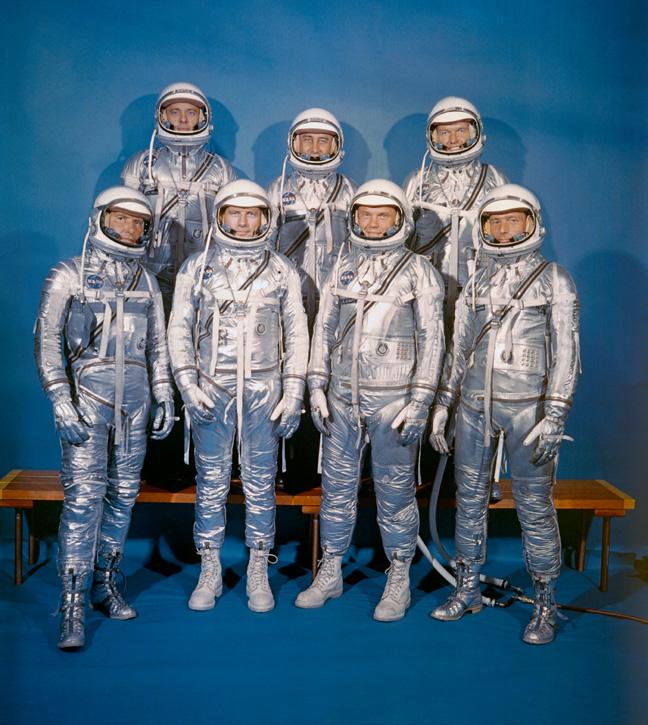
12
Figure 1.1 The original seven astronauts selected in 1959 for the Mercury Program. Front row, left to right: Walter Schirra Jr., Donald Slayton, John Glenn Jr., and M. Scott Carpenter. Back row, left to right: Alan Shepard Jr., Virgil Grissom, and L. Gordon Cooper Jr., PHOTOGRAPH BY NASA
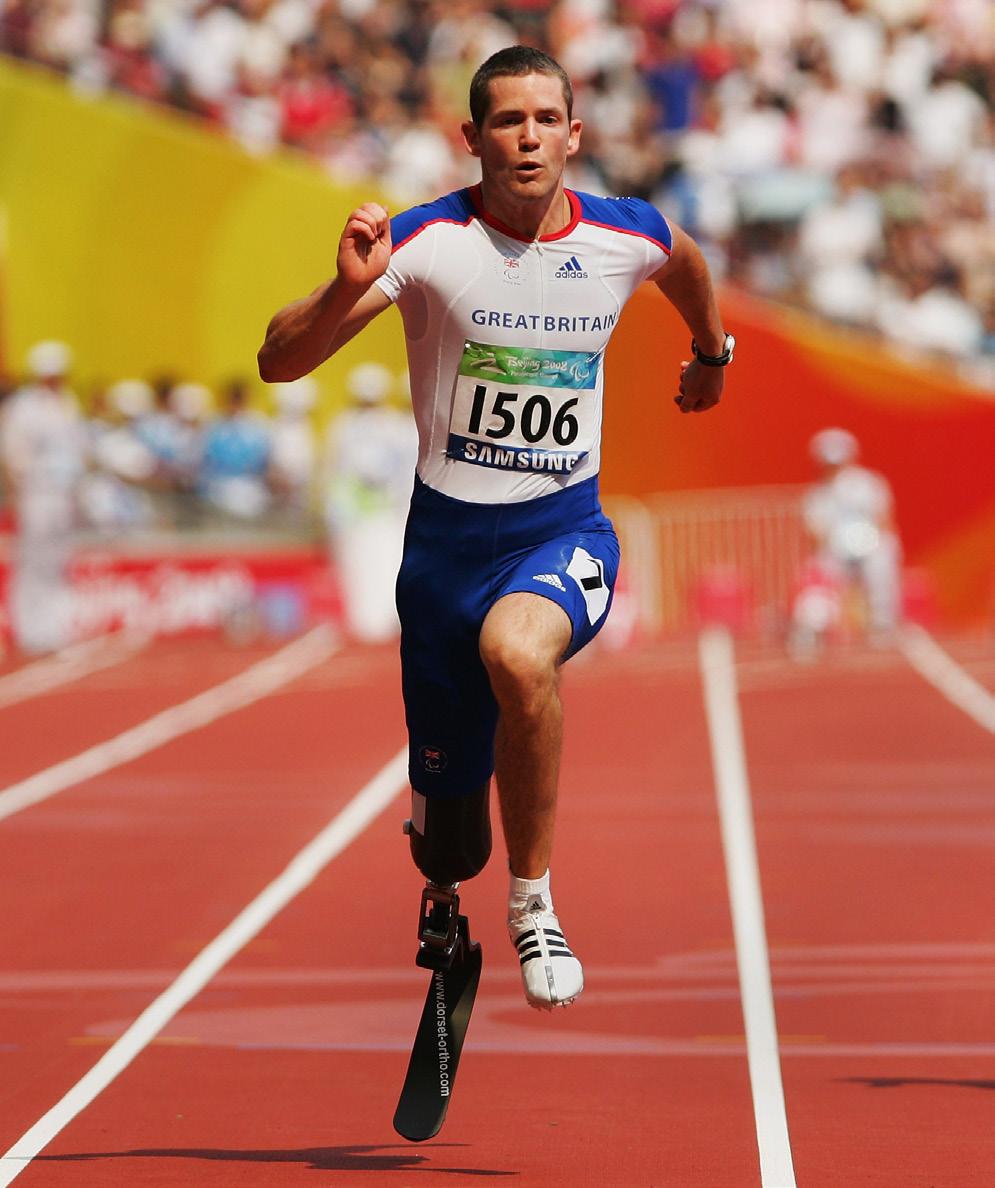
13
the Right Stuff
Beyond
Figure 1.2 BEIJING - SEPTEMBER 14: John McFall of Great Britain in the fnal of the Men’s 100M -T42 Athletics event at the National Stadium during day eight of the 2008 Paralympic Games on September 14, 2008 in Beijing, China, PHOTO BY ANDREW WONG
Universal design and inclusive design are two valid frameworks for designing for disability inclusion in human space ight. Universal design, as de ned in Barrier-Free Design, aims to create products, environments, programs, and services that are usable by the maximum number of people, without the need for any adaptations or special con gurations. However, the limitation of this approach is that it tries to appeal to the broadest user group possible and may result in designs that fail to meet the needs of many individuals.
Inclusive design however, is a design approach that is centered around the needs of speci c individuals or groups. By designing for a speci c user, inclusive design can improve the usability of the product, environment, or experience for the intended user. is, in turn, may also improve the design for a wider range of users, making it a more universal solution than a design that results from a universal design approach.

14
Figure 1.3 The 12 Ambassadors of AstroAccess’ Flight 1 in front of Zero G Corporation’s G-Force One aircraft on the tarmac of Long Beach Airport PHOTO BY AL POWERS FOR ZERO GRAVITY CORPORATION
Co-design, or designing with the intended users, is considered the most valuable and informative means of conducting inclusive design, allowing for understanding to be directly gathered from the individuals who will use the product, environment or experience. is direct engagement with users creates a more human-centered approach to design and provides the designers with insights that may have been overlooked through other methods, rather than making assumptions based on generalizations or stereotypes. Co-design can consist of any combination of prototyping, workshops, focus groups, user testing, and direct collaboration with individuals. is process allows designers to see the challenges that individuals with disabilities face and to better understand how the designs can meet those needs. It also provides the opportunity for users to provide feedback and o er suggestions for improvement.

15 Beyond the Right Stuff
e co-design approach I used for my research was based on the idea that the best way to design accessible objects, environments, and interfaces for microgravity was to involve individuals with disabilities in the design process. rough workshops and facilitated conversations, I aimed to gather insights and perspectives from the users to inform the design.
Prototyping was an important part of the co-design process as it allowed me to take a human-centered approach to the design of accessible objects, environments, and interfaces for microgravity. By working directly with individuals who have mobility and sensory disabilities, I developed a series of prototypes that demonstrate the feasibility and bene ts of inclusive design in microgravity environments. ese prototypes serve as a starting point for the development of more accessible and usable microgravity environments for people with disabilities, and as a model for other space-related activities. e co-design approach also created a more equitable design process, resulting in more inclusive and e ective solutions.
rough this book, I aim to share my thesis work and demonstrate the importance of inclusive design practices in human space exploration. By including people with disabilities in the design process, we can ensure that the bene ts of human space ight are available to everyone, regardless of their abilities.Universal design and inclusive design are two valid frameworks for designing for disability inclusion in human space ight. Universal design, as de ned in Barrier-Free Design, aims to create products, environments, programs, and services that are usable by the maximum number of people, without the need for any adaptations or special con gurations. However, the limitation of this approach is that it tries to appeal to the broadest user group possible and may result in designs that fail to meet the needs of many individuals.
Inclusive design however, is a design approach that is centered around the needs of speci c individuals or groups. By designing for a speci c user, inclusive design can improve the usability of the product, environment, or experience for the intended user. is, in turn, may also improve the design for a wider range of users, making it a more universal solution than a design that results from a universal design approach.
Co-design, or designing with the intended users, is considered the most valuable and informative means of conducting inclusive design, allowing for understanding to be directly gathered from the individuals who will use the product, environment or experience. is direct engagement with users creates a more human-centered approach to design and provides the designers with insights that may have been
16
Universal Design
The design of products and environments to be usable by all people, to the greatest extent possible, without the need for adaptation or specialized design

Inclusive Design
The design of products and environments that are accessible through the inclusion of marginalized individuals in the design process
Disability-Led Design

The framework of design being led by people with disabilities, ensuring their perspectives and needs are at the forefront of the design process

17 Beyond the Right Stuff
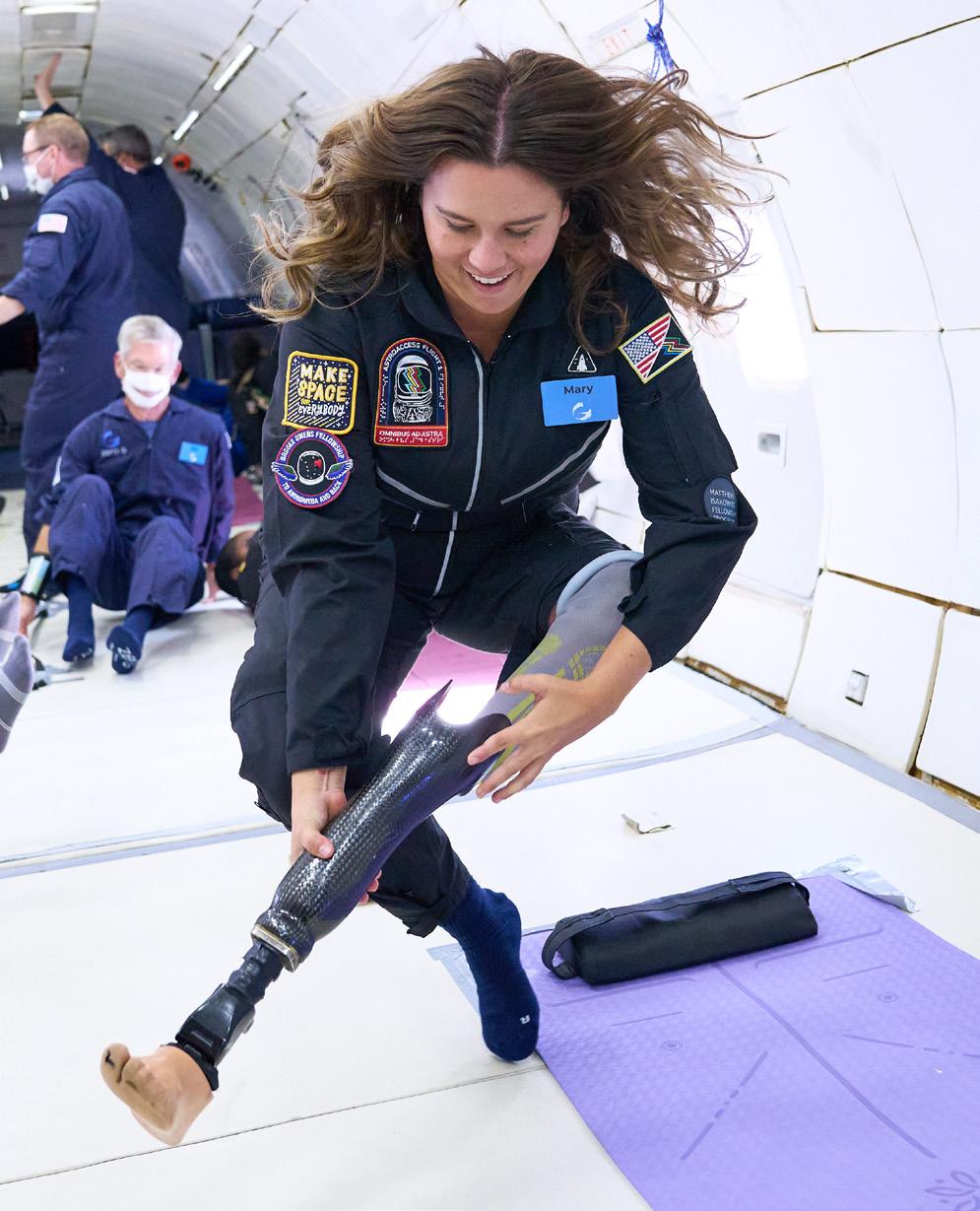
18
Figure 1.4 Mary Cooper on AstroAccess’ Flight 1 removing her prosthetic leg in zero G PHOTO BY AL POWERS FOR ZERO GRAVITY CORPORATION
overlooked through other methods, rather than making assumptions based on generalizations or stereotypes. Co-design can consist of any combination of prototyping, workshops, focus groups, user testing, and direct collaboration with individuals. is process allows designers to see the challenges that individuals with disabilities face and to better understand how the designs can meet those needs. It also provides the opportunity for users to provide feedback and o er suggestions for improvement.
e co-design approach I used for my research was based on the idea that the best way to design accessible objects, environments, and interfaces for microgravity was to involve individuals with disabilities in the design process. rough workshops and facilitated conversations, I aimed to gather insights and perspectives from the users to inform the design.
Prototyping was an important part of the co-design process as it allowed me to take a human-centered approach to the design of accessible objects, environments, and interfaces for microgravity. By working directly with individuals who have mobility and sensory disabilities, I developed a series of prototypes that demonstrate the feasibility and bene ts of inclusive design in microgravity environments. ese prototypes serve as a starting point for the development of more accessible and usable microgravity environments for people with disabilities, and as a model for other space-related activities. e co-design approach also created a more equitable design process, resulting in more inclusive and e ective solutions.
rough this book, I aim to share my thesis work and demonstrate the importance of inclusive design practices in human space exploration. By including people with disabilities in the design process, we can ensure that the bene ts of human space ight are available to everyone, regardless of their abilities. e co-design approach I used for my research was based on the idea that the best way to design accessible objects, environments, and interfaces for microgravity was to involve individuals with disabilities in the design process. rough workshops and facilitated conversations, I aimed to gather insights and perspectives from the users to inform the design.
Prototyping was an important part of the co-design process as it allowed me to take a human-centered approach to the design of accessible objects, environments, and interfaces for microgravity. By working directly with individuals who have mobility and sensory disabilities, I developed a series of prototypes that demonstrate the feasibility and bene ts of inclusive design in microgravity environments. ese prototypes serve as a starting point for the development of more accessible and usable
19 Beyond the Right Stuff
microgravity environments for people with disabilities, and as a model for other space-related activities. e co-design approach also created a more equitable design process, resulting in more inclusive and e ective solutions.
rough this book, I aim to share my thesis work and demonstrate the importance of inclusive design practices in human space exploration. By including people with disabilities in the design process, we can ensure that the bene ts of human space ight are available to everyone, regardless of their abilities.Universal design and inclusive design are two valid frameworks for designing for disability inclusion in human space ight. Universal design, as de ned in Barrier-Free Design, aims to create products, environments, programs, and services that are usable by the maximum number of people, without the need for any adaptations or special con gurations. However, the limitation of this approach is that it tries to appeal to the broadest user group possible and may result in designs that fail to meet the needs of many individuals.
Inclusive design however, is a design approach that is centered around the needs of speci c individuals or groups. By designing for a speci c user, inclusive design can improve the usability of the product, environment, or experience for the intended user. is, in turn, may also improve the design for a wider range of users, making it a more universal solution than a design that results from a universal design approach. Co-design, or designing with the intended users, is considered the most valuable and informative means of conducting inclusive design, allowing for understanding to be directly gathered from the individuals who will use the product, environment or experience. is direct engagement with users creates a more human-centered approach to design and provides the designers with insights that may have been overlooked through other methods, rather than making assumptions based on generalizations or stereotypes. Co-design can consist of any combination of prototyping, workshops, focus groups, user testing, and direct collaboration with individuals. is process allows designers to see the challenges that individuals with disabilities face and to better understand how the designs can meet those needs. It also provides the opportunity for users to provide feedback and o er suggestions for improvement.
e co-design approach I used for my research was based on the idea that the best way to design accessible objects, environments, and interfaces for microgravity was to involve individuals with disabilities in the design process. rough workshops and facilitated conversations, I aimed to gather insights and perspectives from the users to inform the design.
20
Prototyping was an important part of the co-design process as it allowed me to take a human-centered approach to the design of accessible objects, environments, and interfaces for microgravity. By working directly with individuals who have mobility and sensory disabilities, I developed a series of prototypes that demonstrate the feasibility and bene ts of inclusive design in microgravity environments. ese prototypes serve as a starting point for the development of more accessible and usable microgravity environments for people with disabilities, and as a model for other space-related activities. e co-design approach also created a more equitable design process, resulting in more inclusive and e ective solutions.
rough this book, I aim to share my thesis work and demonstrate the importance of inclusive design practices in human space exploration. By including people with disabilities in the design process, we can ensure that the bene ts of human space ight are available to everyone, regardless of their abilities.
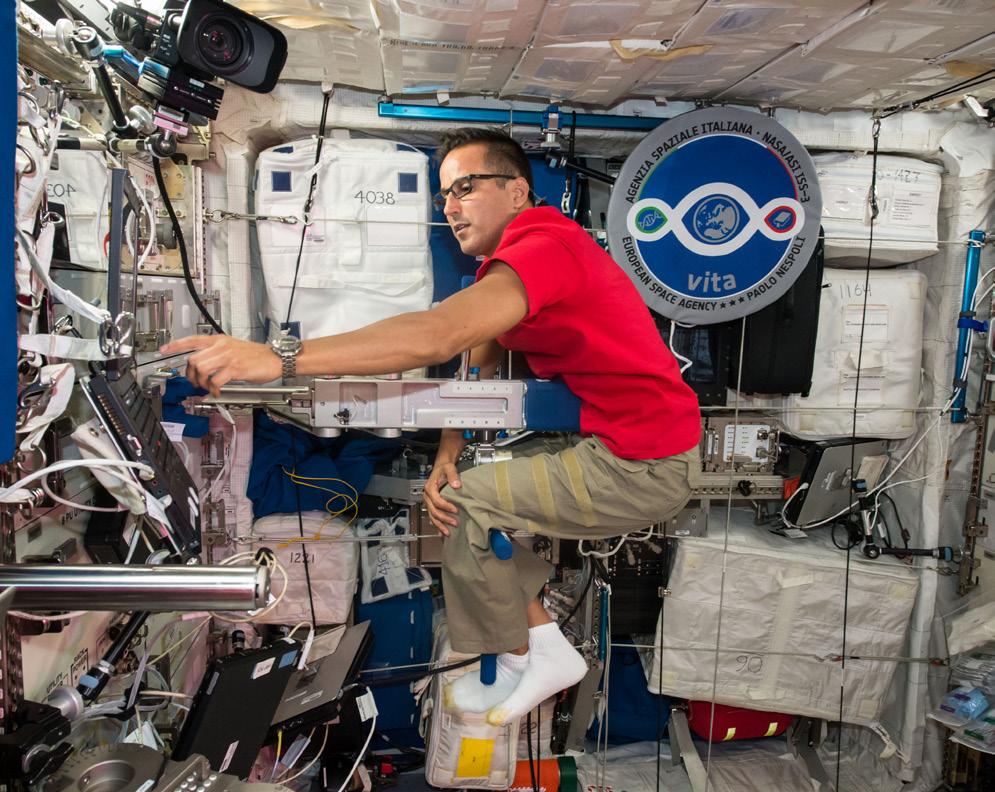
21 Beyond the Right Stuff
Figure 1.5 Joseph Acaba works inside the Columbus lab PHOTO BY NASA

Wearable Anchoring 1
Prototyping for Existing Microgravity Environments
23 Beyond the Right Stuff

24
Figure 2.1 Aerospace student Michaela Benthaus at the TUM School of Engineering and Design with a base plate that was part of a space shuttle ASTRID ECKERT, TUM
Space travel has long been the domain of individuals without disabilities, but with the increasing focus on inclusive design and universal design, there is a growing recognition that people with disabilities should also have the opportunity to participate in space exploration and research. Mobility disabilities, in particular, present unique challenges in microgravity environments, where tasks that require ne motor skills and precise movements can be di cult to perform. In this paper, we explore design solutions for mobility disabilities in space, with a focus on inclusive and universal design principles. We review the current state of the art in this area, highlighting the limitations and challenges of existing solutions, and propose new approaches that could enable people with mobility disabilities to fully participate in microgravity activities. By considering the needs of people with mobility disabilities from the outset, we can create more inclusive and accessible space environments that bene t everyone.
As I embarked on designing for disability inclusion in space, I had the privilege of meeting Michi Benthaus, a remarkable woman whose life experiences have inspired the innovative technology we are developing. Michi is an engineering student from Germany who has a spinal cord injury that resulted in paralysis below her waist. Despite this signi cant challenge, Michi’s kind and humble demeanor is infectious, and she maintains a positive outlook on life that is truly inspiring.
Michi’s short blonde hair and expressive face are a testament to her character. Her infectious laughter and ability to communicate exactly how she feels about a good idea leave a lasting impression on all those who meet her. It was through our conversations that Wearable Anchoring was born, an innovative technology designed to help people like Michi in their daily lives.
Our project involved developing experiments for Michi to execute on a zero-gravity ight with AstroAccess. We wanted to explore what life would look like for her in space and observe how we could create solutions to the unique challenges she faced. We realized that completing tasks such as working on a payload, recording an interview, or even playing the ute, required one to anchor or stabilize oneself using their feet to prevent oating around the cra .
Astronauts aboard the International Space Station (ISS) need to anchor themselves in order to perform tasks that require stable positioning, as microgravity causes objects and bodies to oat freely. Currently, astronauts use handrails, foot restraints, and other tethering devices to anchor themselves during their missions. e handrails are attached to various surfaces throughout the ISS, and astronauts can grip onto
25 Beyond the Right Stuff
them to maintain stability. e foot restraints are used to hold the astronauts in place while they perform tasks that require them to use their hands, such as repairs or experiments. Since these techniques are dependent on the use of lower limbs, the current anchoring methods have limitations for crew members who have low or no muscular control of their feet and legs or who don’t have feet or legs at all.
Adapting to an existing environment is a valid approach that can be applied on Earth and in space. is is especially relevant for the International Space Station, where redesigning the entire structure would be both cost-prohibitive and technically challenging. While not ideal, adapting to an environment involves working with the existing constraints, taking into account the existing layout, infrastructure, and other elements, and nding ways to optimize the new design within these limitations. is is the approach that was taken for the challenge at hand.
e approach taken to the prototype designs involved co-design methodologies, conversations with potential users, user-testing, and testing in a parabolic ight. e co-design sessions were conducted with a group of potential users to gather insights and co-create solutions that met their needs. e conversations with potential users helped to further re ne the prototype designs and ensure that they aligned with user needs and preferences.
User-testing was also an important aspect of the design process. e prototype designs were tested by potential users to identify any areas that needed improvement. Feedback from users was used to make changes and adjustments to the prototypes, ensuring that they met the needs of the intended users.
Finally, the prototypes were tested in a parabolic ight to simulate the microgravity environment of the ISS. is allowed for further testing and re nement of the designs before they were implemented on the actual space station. By using a combination of co-design methodologies, conversations with potential users, user-testing, and testing in a parabolic ight, the prototype designs were able to be optimized for use on the ISS.
is study aimed to explore the e ectiveness of two prototypes for anchoring devices designed for people with mobility disabilities in microgravity environments. e study included six research partners with mobility disabilities, three of whom had paralysis below the waist due to spinal cord injury (SCI), and three with double amputation. All participants had experience performing tasks in microgravity environments and provided feedback on the usability and e ectiveness of the prototypes.
26

27 Beyond the Right Stuff
Figure 2.2 ESA astronaut Alexander Gerst transfers a robotic arm and multi-purpose experiment platform through the Kibo module’s scientifc airlock in the ISS
PHOTO BY NASA
 Figure 2.3 NASA astronaut Cady Coleman plays a fute in the JAXA Kibo laboratory onboard the ISS during free time PHOTO BY NASA
Figure 2.3 NASA astronaut Cady Coleman plays a fute in the JAXA Kibo laboratory onboard the ISS during free time PHOTO BY NASA

 Figure 2.4 Sketches exploring a variety of attachment methods including velcro, clips, and magnets
Figure 2.4 Sketches exploring a variety of attachment methods including velcro, clips, and magnets

31 Beyond the Right Stuff
To evaluate the e ectiveness of the prototypes, the study used a pre-post design. Participants completed a modi ed version of the functional dexterity test (FDT) both before and a er using the prototypes. e FDT is a standard measure of ne motor skills commonly used in microgravity research. In the modi ed version of the FDT, participants were asked to remove two pegs from a board and switch their locations using only their hands.
Two prototypes were developed speci cally for this study. e rst prototype was a waist harness with telescoping arms that attached to a wall of a space station. e second prototype was a leg strap that attached to a handhold. Both prototypes were designed to allow the user to stabilize themselves with their feet or legs, freeing up their hands to perform tasks that require ne motor skills.
e study was conducted on a series of zero-G parabolic ights, which provided a simulated microgravity environment. Participants used the prototypes in a counterbalanced order, and a er each use, they completed a survey to provide feedback on the usability and e ectiveness of the device.
e data collected during the study included the time required to complete the FDT and the accuracy of peg placement. Paired t-tests were used to analyze the data to determine whether the use of the prototypes was associated with signi cant improvements in performance. e survey data were analyzed using thematic analysis to identify common themes in the participants’ feedback.
32
Figure 2.5 Two wearable anchoring devices, one worn on the waist as a belt with hip attachments, and the other worn on the legs with clips, shown in front and side views
In the study, two prototypes were tested to see how they could improve the performance of individuals with mobility disabilities in microgravity environments. e results showed that both prototypes had potential, but the waist harness prototype was more successful than the leg strap prototype.
e waist harness prototype was used by three research partners with SCI, and they all reported signi cant improvements in their performance on the modi ed FDT a er using the prototype. e average time required to complete the FDT decreased by 30%, and the accuracy of peg placement improved as well. e success of the waist harness prototype was attributed to the two attachment points, which provided greater stability and control, and the placement of attachments near the participants’ center of mass, which made it easier to maintain balance and orientation.
However, the leg strap prototype was less successful. e single point of contact provided by the leg strap did not give the research partners enough control to perform the modi ed FDT e ectively. erefore, the time required to complete the FDT did not improve, and the accuracy of peg placement decreased.
In conclusion, the study suggests that the waist harness prototype has the potential to improve the ability of individuals with mobility disabilities to perform tasks in microgravity environments. However, further research is needed to optimize the design of the waist harness and to assess its performance in more realistic scenarios.
e results of this study suggest that the waist harness prototype has the potential to enhance the ability of individuals with mobility disabilities to perform tasks in microgravity environments. e use of the waist harness was associated with signi cant improvements in both the time required to complete the modi ed functional dexterity test (FDT) and the accuracy of peg placement. ese ndings support the idea that anchoring devices can be an e ective solution for people with mobility disabilities in microgravity environments, and they highlight the importance of inclusive and universal design principles in the development of these devices.
One of the key strengths of the study was the use of zero-G parabolic ights, which provided a simulated microgravity environment that allowed for realistic testing of the prototypes. is enabled the research team to evaluate the performance of the prototypes under conditions that were more representative of the challenges faced by people with mobility disabilities in space.
However, it is important to note that the study had several limitations that should
33 Beyond the Right Stuff

34
Figure 2.6
3D printed prototypes depicting the process of creating the fnal prototypes, and an unfnished functional dexterity test made from wooden dowels and CNC’d plywood
be taken into consideration when interpreting the results. First, the sample size was small, with only six research partners participating in the study. is limits the generalizability of the ndings, and larger studies with a more diverse sample of participants will be needed to con rm the results of this study. Second, the modi ed FDT used in the study was a simpli ed version of the original task, and it may not fully capture the complexity of tasks that would be performed in a real microgravity environment. Finally, the study did not evaluate the performance of the prototypes in more realistic scenarios, such as those that would be encountered on a space station or during a space mission.
Despite these limitations, the results of the study provide important insights into the potential of anchoring devices for people with mobility disabilities in microgravity environments. Further research is needed to optimize the design of these devices and to assess their performance in more realistic scenarios. is could include the development of new prototypes that incorporate the feedback of people with mobility disabilities, as well as the use of co-design methodologies to ensure that the needs and preferences of these individuals are taken into account. By considering the needs of people with mobility disabilities from the outset, we can create more inclusive and accessible space environments that bene t everyone.

35 Beyond the Right Stuff
Figure 2.7 The fnal functional dexterity test that few on the zero-G fight, featuring 16 wooden pegs with velcro and one side white and one side black sitting in a wooden board with white duct tape around the edges
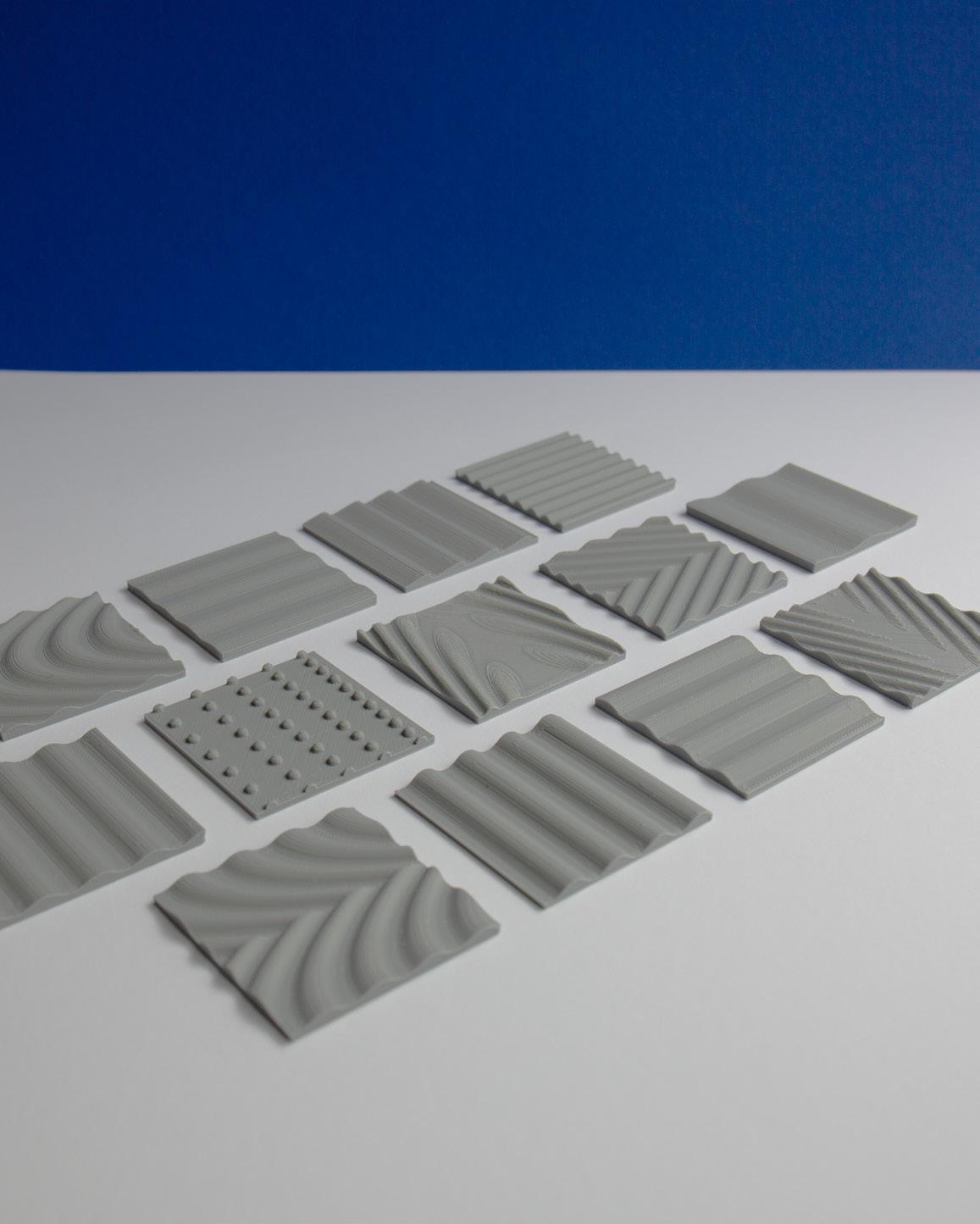
Touch Path 2
Tactile Communication for Traversing and Orientation
37 Beyond the Right Stuff
e aim of this project is to communicate emergency information to astronauts on a space station through tactile iconography, textures, and patterns. is idea started with Dr. Sheri Wells-Jensen for AstroAccess’ second ight. She is a linguist whose research interests lie in areas such as psycholinguistics, language preservation, braille, phonetics, and xenolinguistics. Dr. Wells-Jensen holds the NASA/Library of Congress Chair in Astrobiology, Exploration, and Scienti c Innovation at the Kluge Center. She is also blind.
Currently, the International Space Station (ISS) has no braille system in place and there are no intentional tactile textures, patterns, or iconography. If astronauts need to nd their way to a safe place or locate emergency or medical equipment in a low visibility scenario, they would most likely have to feel their way around the station for contextual clues. is project presents a signi cant opportunity for communicating critical emergency information in such a scenario. e addition of tactile elements to the design of a new space station would have a substantial impact on safety and would come at a relatively low cost.
Additionally, the implementation of this project would signi cantly reduce the barrier of entry for blind and low-vision individuals to live and work in space. By providing critical emergency information through tactile elements, the project would enable these individuals to navigate the space station more e ectively and e ciently, thereby increasing their safety and independence.
e Touch Path project has the potential to revolutionize the design of space stations and increase the safety and accessibility of space. It could be an essential step forward in ensuring equal opportunities for all individuals to live and work in space.
Dr. Wells-Jensen’s expertise in linguistics, braille, and xenolinguistics makes her uniquely quali ed to partner with on the Touch Path project. Her personal experience as a blind person living and working in a world not designed for her has given her a unique perspective on the importance of multimodal communication. By using tactile iconography, textures, and patterns, we seek to create a system that is intuitive and easy to use, even for those who have never encountered braille before. For the development of this project, we collaborated with Chancey Fleet, the Assistive Technology Coordinator at the New York Public Library, to host a workshop aimed at generating ideas with members of the Blind community. Attendees included Danielle Montour, a Technical Support Specialist at the American Printing House for the Blind, Leona Godin, author of “ ere Plant Eyes:
38
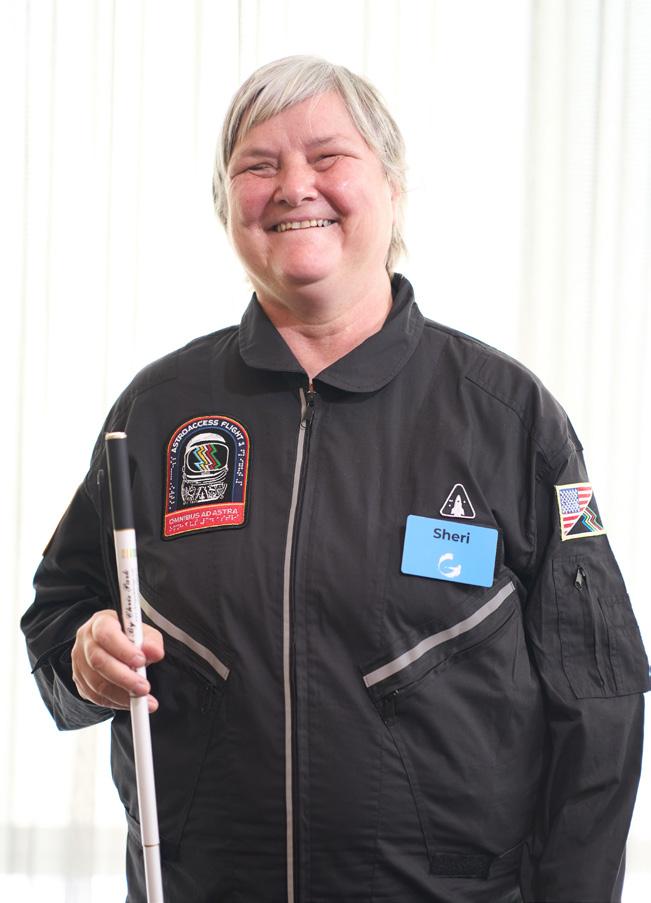
39 Beyond the Right Stuff
Figure 3.1 Dr. Sheri Wells-Jensen wearing the AstroAccess fight 1 fight suit
PHOTO BY AL POWERS FOR ZERO GRAVITY CORPORATION
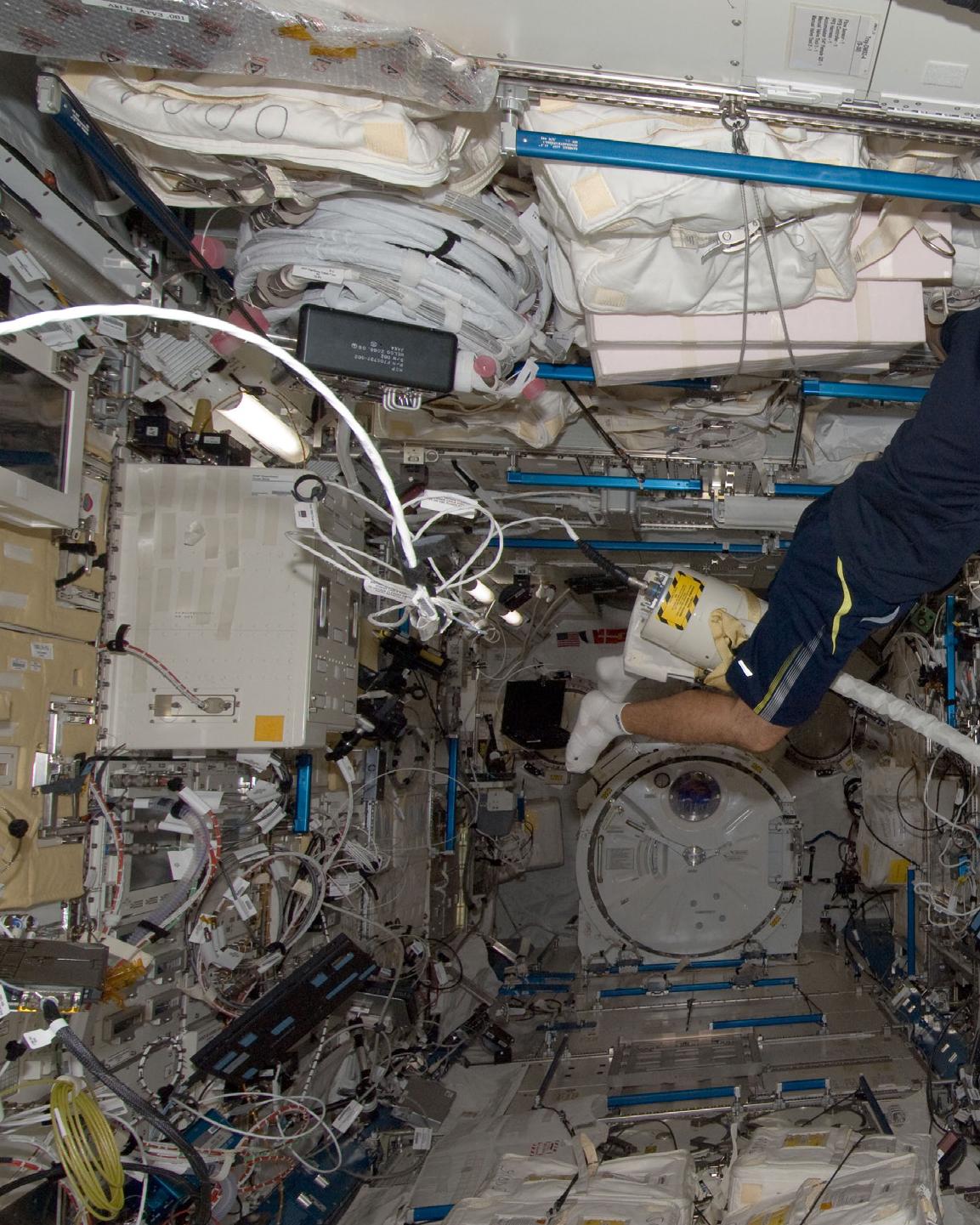 Figure 3.2 JAXA astronaut Aki Hoshide uses a vacuum cleaner during housekeeping operations in the Kibo laboratory of the ISS. PHOTO BY NASA
Figure 3.2 JAXA astronaut Aki Hoshide uses a vacuum cleaner during housekeeping operations in the Kibo laboratory of the ISS. PHOTO BY NASA
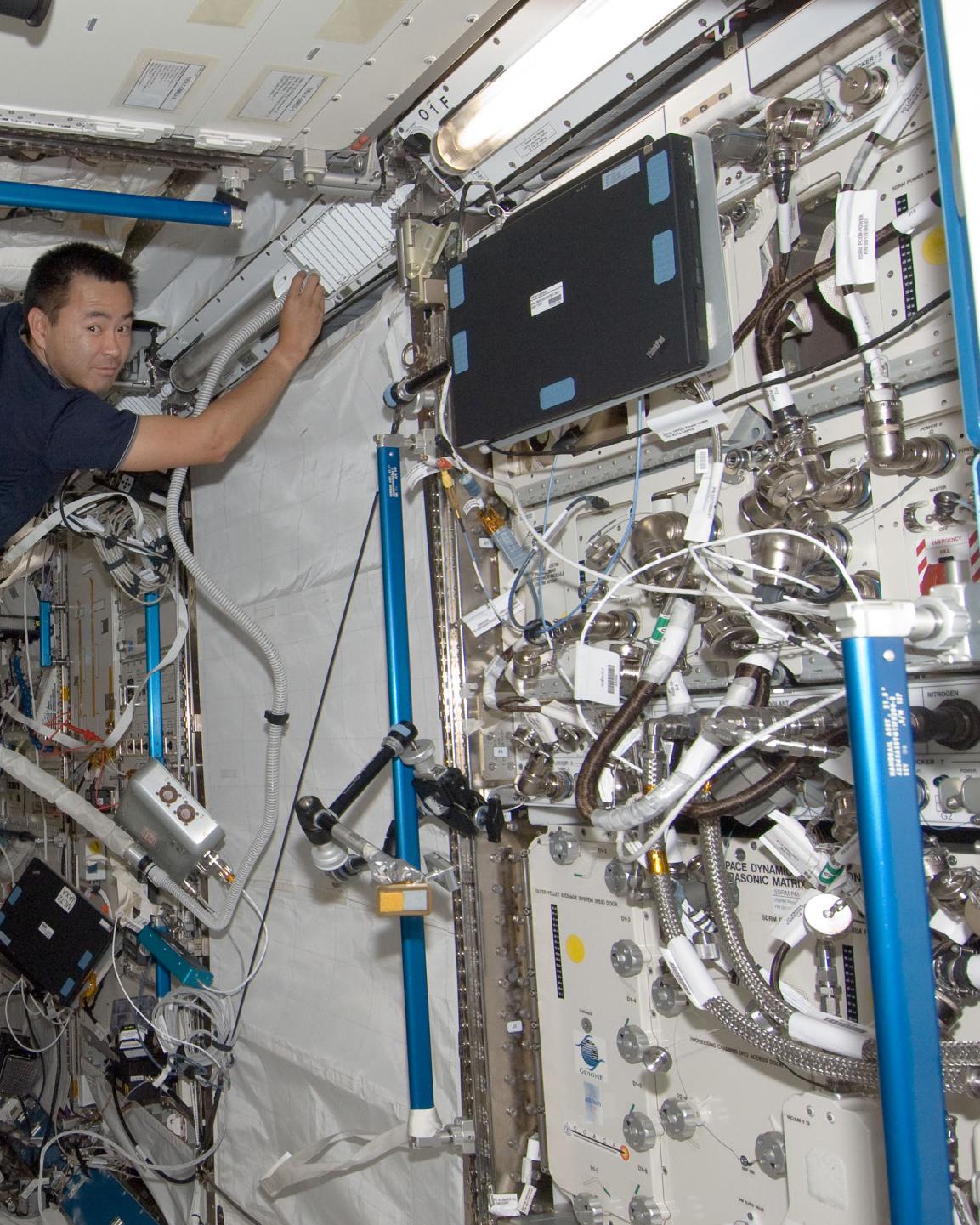
A Personal and Cultural history of Blindness,” and Dr. Mona Minkara, an Assistant Professor of Bioengineering at Northeastern University and leader of the Minkara COMBINE lab.
Sheri and I started the workshop by providing some context for the project, describing life aboard a space station, and discussing the physics of microgravity. I explained the nuances of Newton’s ird Law of Motion, “for every action (force) in nature there is an equal and opposite reaction” and its implications for astronauts’ movements and interactions with objects on the space station.
Next, we introduced various tools that could be used to create tactile patterns and symbols, including sensational blackboards, slates and styluses for manually embossing Braille, and a swell form printer that creates a raised image by causing areas with black ink to pu up. roughout the workshop, attendees were given the opportunity to use these tools to sketch, punch, and print their ideas, passing around their creations and discussing the legibility of di erent patterns and symbols.
During this time, there were some moments of levity, such as when Danielle Montour laughed at my unintentional creation of a series of Gs with the slate and stylus due to my lack of Braille literacy. Leona Godin also felt a piece of stimuli and immediately began drawing with the sensational blackboard, inspired by the tactile sensations.
e team discussed the challenges of relying solely on braille as a means of conveying information to the blind population, as fewer than 10% of legally blind individuals in the United States read braille according to a report by the National Federation of the Blind. is led us to explore alternative ways of conveying information through tactile means that would be more accessible to non-braille readers.
One solution we discussed was creating a tactile icon set that would be intuitive and easy to understand regardless of Braille literacy. By using universally recognized symbols and shapes, such as a cross for medical equipment or a re extinguisher symbol, we could convey important information without relying on language or Braille.
Additionally, we explored the possibility of creating an intuitive shorthand system that could be easily learned and understood by individuals who are not familiar with Braille. e team acknowledged that creating a shorthand or icon set would have the added bene t of being more accessible to non-Braille readers, which could potentially increase the number of people who could access this information.
42
e workshop provided a space for collaboration and creativity, allowing individuals from various backgrounds and expertise to come together to generate ideas for the Touch Path project.

e handrail design created through our collaboration consisted of two distinct parts: the directional pattern and the shorthand. e directional pattern was used to encode information related to navigating or orienting in a station, while the shorthand was designed to convey important or more detailed information.
e directional pattern was designed to be legible when the thumb moved along the front surface of the rail. is is because thumbs aren’t typically sensitive enough to read braille or detect small di erences.
e shorthand was designed to be legible when the ngers moved along the back of the rail. Important or more detailed information was encoded onto the back of the rail for increased legibility with the ngers. e other bene t of this placement is that the information could be read without propelling the crew member away from the surface.
43 Beyond the Right Stuff
Figure 3.3 Corey McClelland and Dr. Sheri Wells-Jensen leading a co-creation workshop with members of the blind community at the Andrew Heiskell Braille and Talking Book Library PHOTO BY LAUREN MCCLELLAND

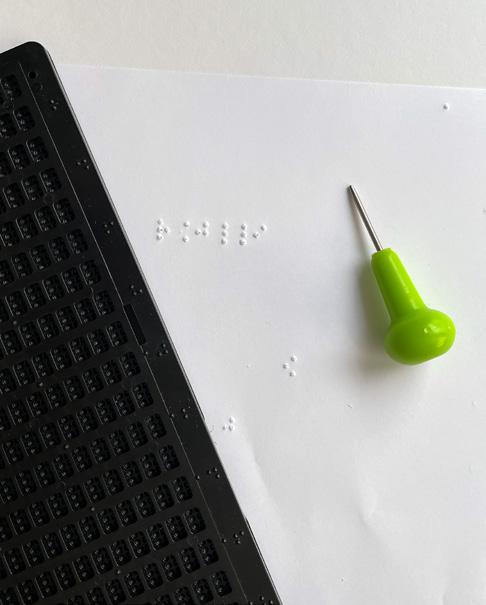

44
Figure 3.4 (top) Seven different directional textures; Figure 3.5 (bottom left) A slate and stylus used to manually punch braille; Figure 3.6 (bottom right) A pile of papers with tactile lines, patterns, and arrows; Figure 3.7 (opposite) Two people passing directional textures to each other during the workshop PHOTO BY LAUREN MCCLELLAND

 1. Angle
2. Depth
3. Density
4. Diffusion
5. Severity
6. Slope
1. Angle
2. Depth
3. Density
4. Diffusion
5. Severity
6. Slope
To better understand the design decisions we had available to us, we developed a nomenclature to describe the di erent attributes of a directional pattern, including angle, depth, density, di usion, severity, slope, and material/surface quality. ese variables could be combined in di erent ways to encode information related to direction of travel, proximity to the next habitat, and other important information.
Variables for Directional Patterns
1. Angle - this describes the angle formed at the shape intersection at the center of the rail. A high value for this variable results in a sharper point at the middle and lower value results in a more subtle angle. Zero results in horizontal lines.
2. Depth - the height of the trough and crest. Subtle di erences in this variable are less perceptible, but easily perceptible when high values are placed next to low values resulting in waveforms comparable to seismic waves
3. Density - this describes the compression of the repeated shapes. A high value results in shapes that are extremely close to each other, more closely resembling a texture. A low value results in a slow undulation across the pattern. is variable heavily impacts legibility of directionality
4. Di usion - A high value for di usion results in an impression of the pattern. is is the tactile equivalent of pixelization. A low value results in the solid clearly de ned shapes
5. Severity - this describes the midpoint of the pattern and the angle at which the symmetrical shapes meet. A high value results in a sharp point at the middle and a low value results in a so arc. e mid-value results in straight lines intersecting to form a chevron pattern
6. Slope - this describes the direction a waveform crest is being pulled. A high value pulls the crest towards the front of the pattern and a low value pulls the crest towards the back of the pattern. Both of these result in shapes similar to cli s and valleys. e mid-value results in a shape similar to even rolling hills
7. Material/surface quality - information can also be encoded in the material choice of the rail or the surface quality (ie glossy vs matte nishes)
By separating the directional pattern and shorthand, we were able to create a design that was accessible to a wider range of users. e shorthand could convey information that might be too complex or detailed to encode in the directional pattern, while the directional pattern could convey information that was more easily communicated through a lower-sensitivity digit.
One of the most signi cant bene ts of the Touch Path project is its low cost. e addition of tactile elements to the design of a space station would be a relatively inexpensive process, especially compared to the potential bene ts in terms of safety and accessibility. is makes it an attractive option for future space missions, as it could signi cantly improve the quality of life for those who live and work in space.
e Touch Path project represents an important step forward in the quest for a more inclusive and accessible space program and is an exciting development in the eld of space exploration.
47 Beyond the Right Stuff

48


SENSE 3
System Emergency Notifcation and Safety Equipment
51 Beyond the Right Stuff
Inclusive and accessible design is crucial when it comes to creating safer environments and experiences. By designing with a focus on accessibility, we can ensure that everyone, regardless of ability, can navigate and interact with their environment with ease. In the context of safety, inclusive and accessible design can make all the di erence in communicating important information during emergency situations. For example, designing warning systems that use both visual and auditory cues can ensure that people with hearing impairments are able to receive the same information as those without. Additionally, designing emergency response plans that take into account the needs of people with disabilities can ensure that everyone has a clear understanding of what to do next and where to go in the event of an emergency. By prioritizing inclusive and accessible design, we can create safer and more equitable environments for everyone.
In the context of safety, inclusive and accessible design can be especially bene cial. By designing for a wide range of users, including those with disabilities, we can ensure that everyone has access to the information and resources they need to stay safe. For example, in the case of the Caution and Warning System aboard the International Space Station, an inclusive and accessible design approach could ensure that the system is not only easy to use and understand for able-bodied astronauts, but also for those with visual or hearing impairments, cognitive disabilities, or language barriers. is could include features such as audible alerts and visual indicators that are easily distinguishable by individuals with colorblindness. An inclusive and accessible design approach could also ensure that the system provides clear and concise information about what’s happening, where it is, what to do next, and where to go, which is critical in emergency situations where time is of the essence. Ultimately, an inclusive and accessible design approach to safety systems can help ensure that everyone has the opportunity to be safe and secure, regardless of their abilities or backgrounds.
e Caution and Warning System aboard the International Space Station (ISS) is a built-in interface designed to alert the crew and ground of any potential issues during their mission. e C&W subsystem triggers alerts when conditions endanger the safety of the crew or station, threaten mission success, or indicate out-of-tolerance conditions. e alerts are grouped into four classes, ranging from class 1 (lifethreatening) to class 4 (system information advisory). Each class is associated with a tone and color that corresponds to the urgency of the situation.
e C&W panel is located over the hatch and consists of ve push-button lights. ree buttons are for emergencies ( re, loss of pressure, and toxic atmosphere), one for warning, and one for caution. e emergency and warning buttons are red, and
52
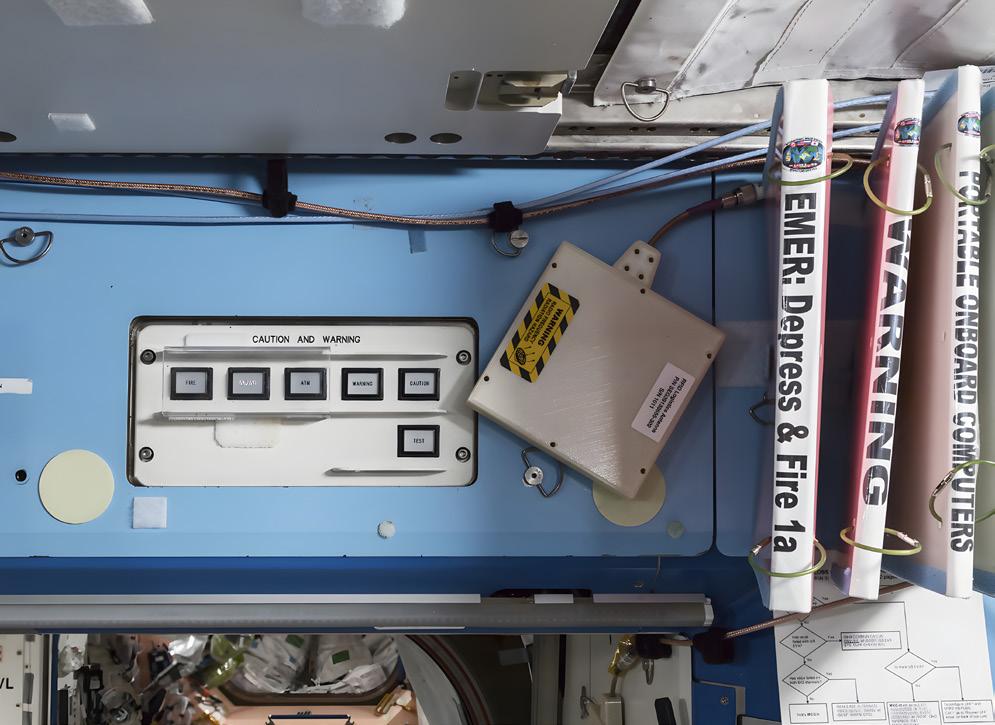
53 Beyond the Right Stuff
Figure 4.1 Caution and Warning Panel, Emergency Procedures Manuals US Laboratory – Destiny International Space Station – ISS Low Earth Orbit
PHOTO BY PAOLO NESPOLI AND ROLAND MILLER

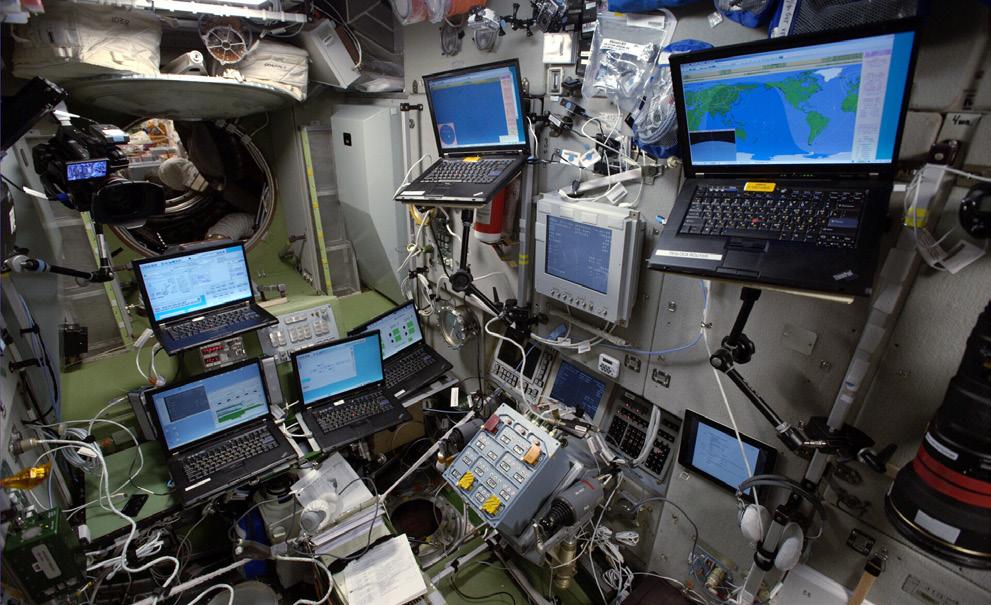
54
Figure 4.2 (top) The setup in the Russian Zvezda module on the ISS shortly before the docking of Europe’s ATV-5
PHOTO BY ESA ASTRONAUT ALEXANDER GERST Figure 4.3 (bottom) Caution and warning tool PHOTO BY DLR (CC-BY 3.0)
the caution button is yellow. Additionally, there is a test button that ensures the lights are functioning correctly.
e top row of the panel has ve buttons (Fire, Δ P, ATM, Warning, and Caution), and the bottom row has one button (Test). e buttons are approximately 1 inch by 3/4 inch each. e C&W subsystem is critical to the safety and success of the mission, and it allows the crew to respond quickly and e ectively to any emergencies that may arise.
e caution and warning system aboard the ISS is a critical component in ensuring the safety of the crew and the station. However, there are several issues with the system that need to be addressed to improve its e ectiveness in communicating information, especially to users with disabilities.
One signi cant issue with the system is the lack of relevant information available on the interface. Although the buttons light up and a tone is played to alert the crew of an emergency, there is no additional information readily available. is can be problematic, especially in high-stress situations where quick decision-making is crucial. Crew members may need to navigate to a computer, open the alerts application, and review the details of the alert to gain a complete understanding of the situation. is delay in information can lead to confusion and errors in judgment, which can jeopardize the safety of the crew and the station.
Another area for improvement is in multi-modal communication. e caution and warning system currently relies on lights and sounds to communicate information to the crew. While this works for most users, it may not be su cient for crew members who have hearing or vision impairments. Adding multi-lingual voice over would greatly improve communication e ectiveness and ensure that all crew members, regardless of their language abilities, can understand the alerts.
In low-visibility scenarios or for blind/low-vision crew members, the caution and warning system falls short in providing tactile information. All of the buttons on the panel are the same size, with at printed graphics, making it di cult to distinguish between them by touch alone. is lack of tactile information can make it di cult for crew members with visual impairments to understand which buttons to press in emergency situations.
e interface itself is also confusing, with the caution and warning buttons having a single function of suppressing an alert, the emergency buttons having the dual function of activating an emergency and suppressing the emergency tone, and the
55 Beyond the Right Stuff
test button running a test of system functionality. is confusion can lead to errors, especially in high-stress situations where clarity and simplicity are critical.
Lastly, the buttons on the physical panel have been known to be accidentally pressed, leading to unnecessary alarms. To address this issue, a removable plastic cover was added to shield the three emergency buttons. However, this cover can be misplaced, leading to accidental button presses once again.
Designing an emergency interface for a space station is a task that requires a great deal of attention to detail, understanding of the environment, and empathy for the endusers. In this project, I took a holistic approach to the existing emergency interface aboard the International Space Station (ISS) and performed a heuristic evaluation utilizing Nielsen’s heuristics to identify areas for improvement. is evaluation revealed ten key issues that needed to be addressed to improve the usability and e ectiveness of the emergency interface.

56
Figure 4.4 A 3D printed model of the ISS Caution & Warning interface used in the workshop

57 Beyond the Right Stuff
Figure 4.5 ESA astronaut Matthias Maurer tapes caution labels to the Tranquility module’s oxygen generation assembly in the ISS PHOTO BY NASA
Existing System
Re-designed System
58
Heuristic Evaluation of the Existing System
1 2 3 4 5 6 7 8 9
Visibility of system status
• Interface does not display anything when system is nominal, creating uncertainty among crew
• No clear visual indication if caution, warning, and emergency alerts have been silenced
Match between the system and the real world
• Emergency buttons are coded for brevity, may be confusing to inexperienced crew
• Hierarchy between caution and warning is confusing
User control and freedom
• Experience is primarily based on binary controls (o /on)
• Manually initiated emergencies can only be cleared by ground control
• Alerts can be suppressed from anywhere on the station, creating confusion
Consistency and standards
• Phrasing is standardized but uses industry jargon
Helping users recognize, diagnose, and recover from errors
• Excessive use of codes and abbreviations
Error prevention
• Hierarchy and binary controls create confusion
• Alerts can be suppressed from anywhere on the station, which could be confusing or dangerous
Recognition rather than recall
• Alert suppression is hidden behind primary function buttons
Flexibility and minimalist design
• Only one level of functionality, classi ed as expert
• System only functional for sighted users
Match between the system and the real world
• Experience was designed by engineers for career astronauts
• Excessive training is required to understand this system
• Civillians would have di culty with this system
59 Beyond the Right Stuff


60
Figure 4.6 (top) Sheri showing her preferred angle for reading braille; Figure 4.7 (bottom) A full-sized prototype for an updated Caution & Warning panel

61 Beyond the Right Stuff
Figure 4.8 A lego prototype created in a work session to understand the preferred scale for the device
To help users recognize, diagnose, and recover from errors, codes and abbreviations were reduced and plain language was used more consistently. is makes it easier for inexperienced crew members to understand what is happening and what they need to do in response.
e design also takes into account error prevention, with a focus on reducing confusion and minimizing the risk of accidental activation or suppression of alerts. To this end, the design includes tactile icons and text identi ers, as well as clear visual and audio indicators to help users understand what is happening.
Recognition rather than recall was also considered in the design, with alert suppression made more visible and accessible to users. Instead of being hidden behind the primary function of the buttons, the suppression function is now clearly indicated with a tactile icon of a muted speaker. e ring around the button also illuminates and pulses to show that an alert has been suppressed.
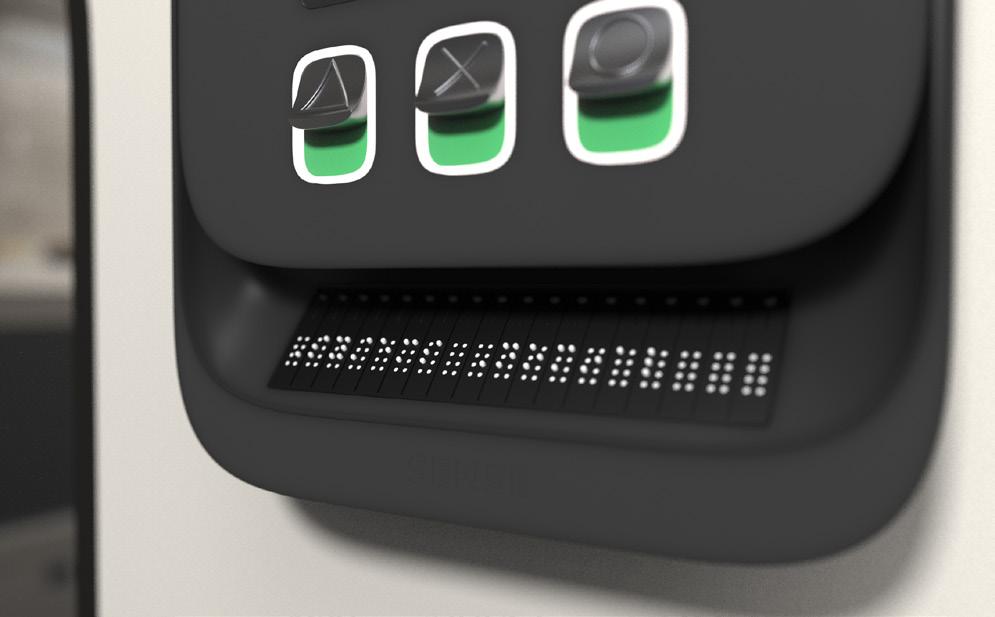
To improve exibility and minimalist design, the new system has only one level of functionality, which can be classi ed as expert. is makes it easier for experienced crew members to quickly understand and use the system, while still providing enough information for less experienced crew members to understand what is happening.
e aesthetic and minimalist design was also addressed in the new prototype. e console information was streamlined and organized with a clear hierarchy, making it
62
Figure 4.9 A braille reader was incorporated into the fnal design to ensure that system information could be communicated in non-visual ways

63 Beyond the Right Stuff
Figure 4.10 The fnal design prioritized multi-modal communcation of system status through the inclusion of an LED display, illuminated rings around the buttons, a braille display, and tactile iconography
easier for crew members to quickly nd the information they need. e information shown was also expanded to include more information on the status of the ship and alerts.
Finally, help and documentation were made more accessible and user-friendly. e documentation is now searchable and available digitally, and procedures related to alerts are included in the main documentation, rather than a separate application.
Overall, the new prototype addresses many of the issues with the existing emergency interface aboard the ISS. By taking a holistic approach and looking at the interface through a UX lens, the new design improves visibility of system status, matches the system more closely to the real world, provides more user control and freedom,
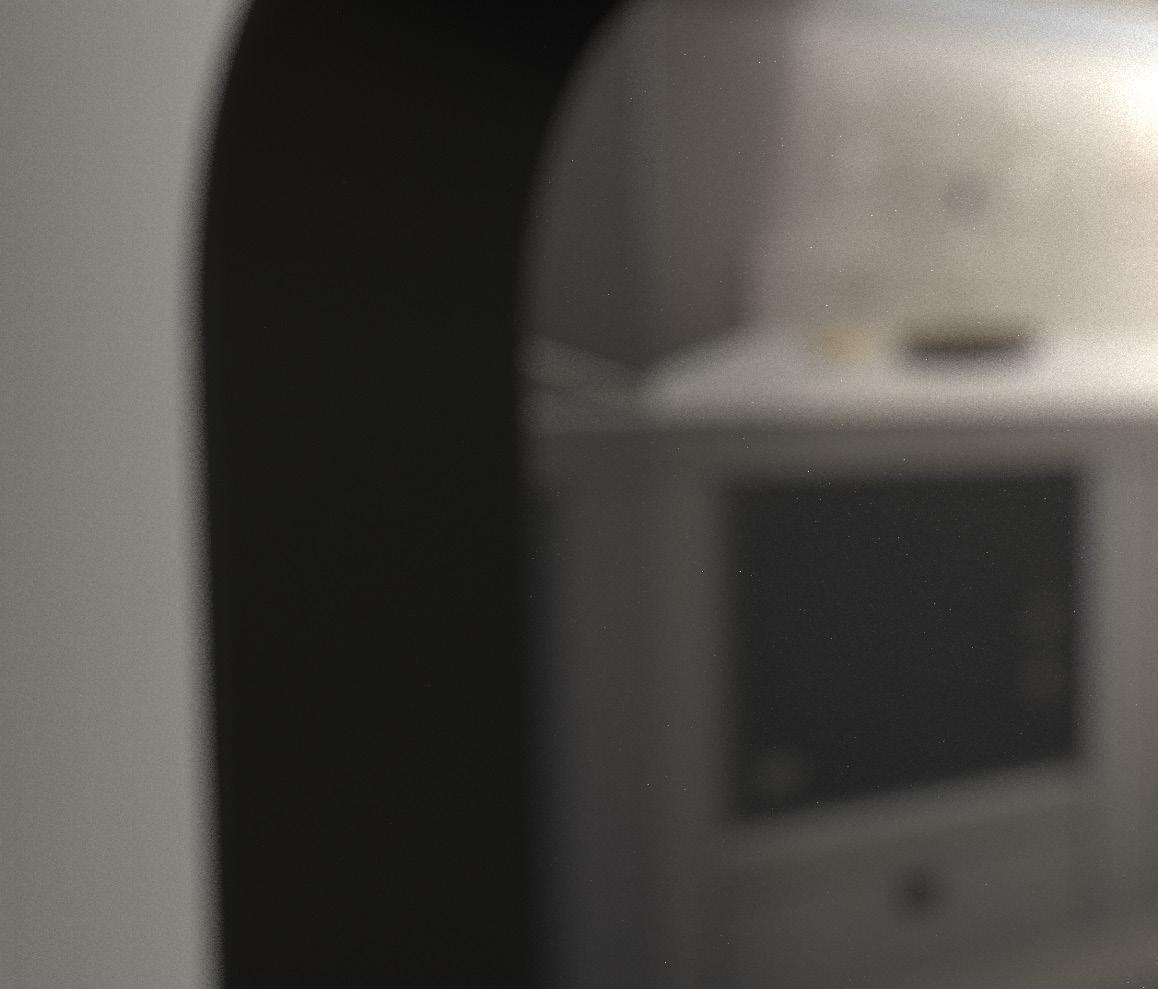
64
Figure 4.11 The redesigned panels would be placed parallel to station thresholds to increase visibility throughout the habitats
ensures consistency and standards, helps users recognize, diagnose, and recover from errors, prevents errors, uses recognition rather than recall, provides exibility and minimalist design, and provides help and documentation in a more accessible and user-friendly way.
e research for this work was done through co-design sessions with blind participants, interviews with d/Deaf participants, and interviews with astronaut Peggy Whitson. is approach ensured that the new design would be accessible to all crew members, regardless of their abilities or experience level. By addressing a wide range of issues and taking a user-centered approach, the new prototype provides a more e ective and e cient emergency interface for the ISS.
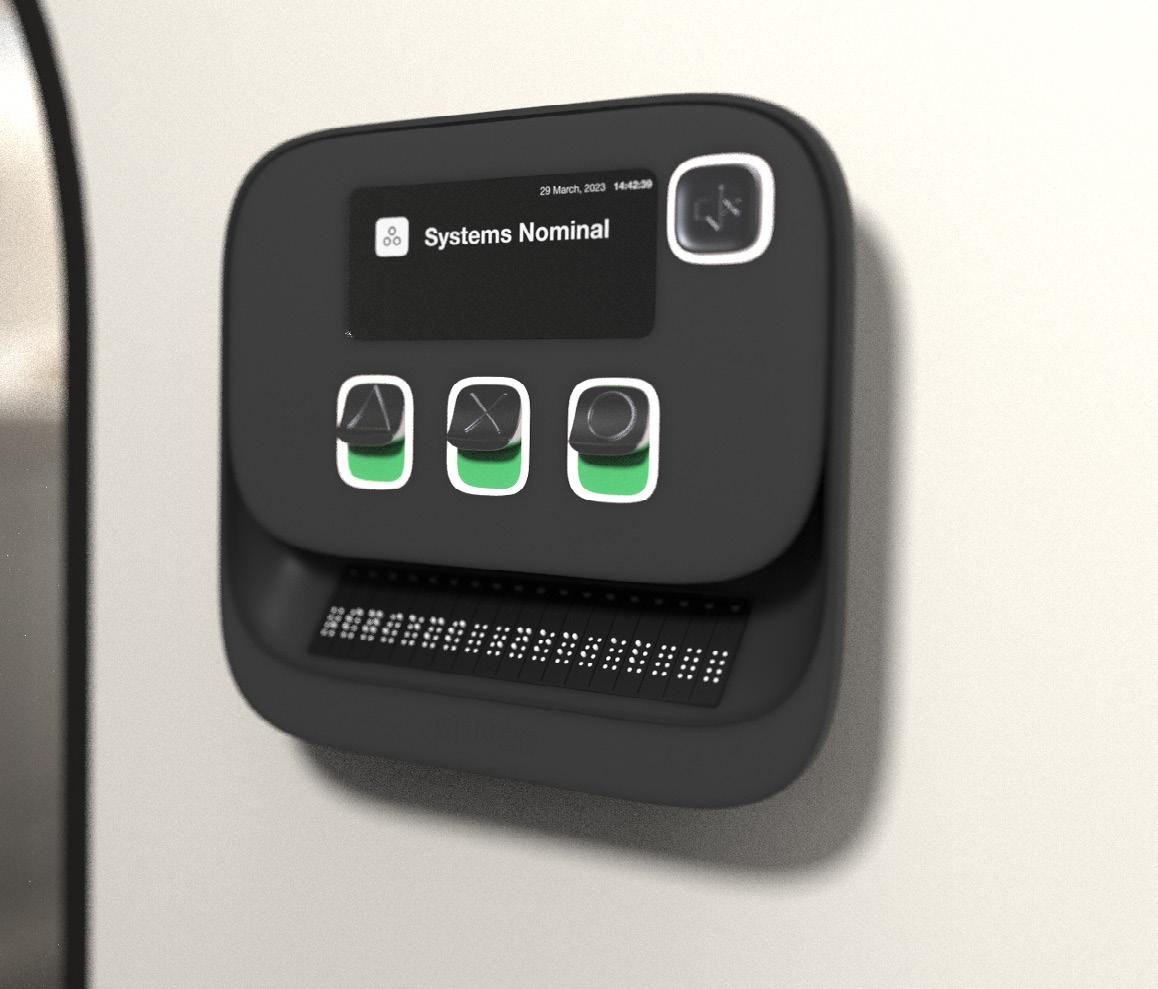
65 Beyond the Right Stuff

MESA 4
Modular Ergonomic Space Accessories
67 Beyond the Right Stuff
e MESA project was born from the idea of helping people with mobility disabilities adapt to microgravity environments. e Wearable Anchoring prototype discussed in a previous chapter had enabled people with paralysis below the waist, lower limb di erence, or lower limb amputations to live and work in microgravity environments, but it required the individual to adapt to an existing environment (the International Space Station). is led me to explore how I could design an environment that adapted to the individual instead.
roughout this project I partnered with Michi Benthaus, an aerospace engineering student and wheelchair user; Viktoria Modesta, a performing artist, model, and amputee; and Sana Sharma, Co-Founder and Chief Design O cer at Aurelia Institute. We sought to reimagine Restraints & Mobility Aids (R&MAs) through the lens of furniture typologies in microgravity environments, focusing on the possibilities of what chairs, tables, and storage could be without the constraints of gravity.
e aim of this work was to empower individuals with disabilities to thrive in space, recognizing that existing microgravity environments posed unique challenges. I wanted to create solutions that enabled everyone to live and work in space, regardless of their physical abilities, inspiring others to rethink design and accessibility in space.
I began by sketching and prototyping, consulting Michi on the technical and ergonomic aspects, Viktoria with her unique perspective to the aesthetic design, and Sana guiding the overall vision and strategy. My focus on ergonomics and adaptability led me to explore a variety of structures and forms. By deconstructing the mental model of “furniture” as we know it and reimagining what chairs, tables, and beds could be without the constraints of gravity, I was able to create solutions that adapted to the individual rather than the other way around.
My early explorations included saddle-like forms that could keep you in place by wedging them into creases of the body, at seats with wings that could wrap around di erent parts of your body, and oversized foam “clips” that you could slide your body into. Later explorations were prototyped using foam and gooseneck stands, which allowed me to experiment with di erent shapes and structures.
I found that the exible arms were a simple and adaptable solution that was unexpectedly comfortable and rigid enough to stabilize in microgravity environments. As I continued prototyping, I explored di erent material
68
Student, Mechatronics Aerospace Engineering

TUM School of Engineering and Design
Performing Artist and Model

Co-Founder and Chief Design Offcer Aurelia Institute

69 Beyond the Right Stuff
Michi Benthaus
Viktoria Modesta
Sana Sharma
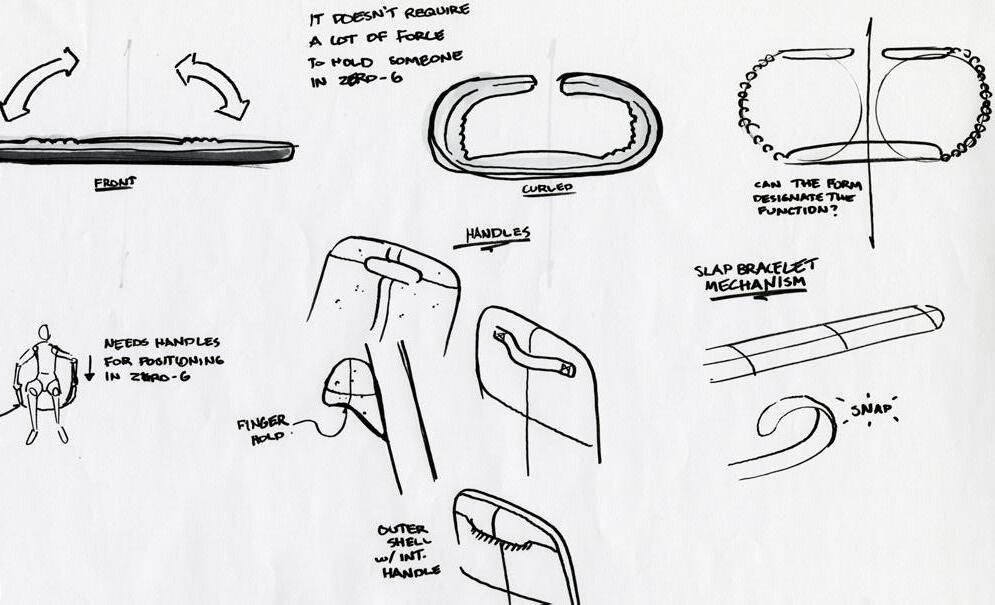
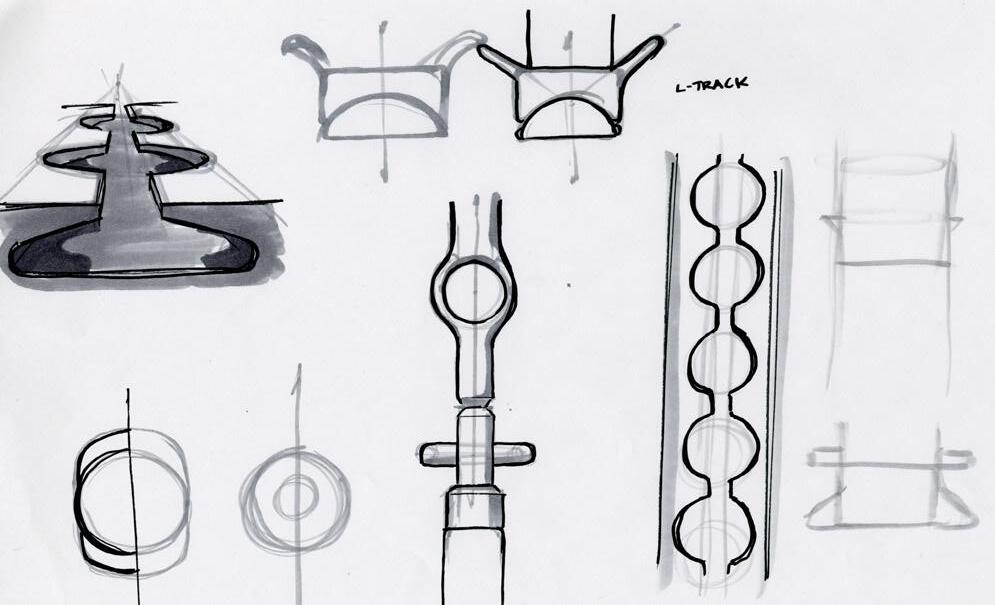
70
Figure 5.1 (Top) Sketches exploring a zero g seat that wraps around the body with a mechanism similar to snap bracelets; Figure 5.2 (Bottom) Sketches of different attachment methods for interfacing with seat track systems

71 Beyond the Right Stuff
Figure 5.3 An illustration outlining the need for addaptive furniture for an individual with an upper limb amputation

72
Figure 5.4 A prototype of the friction ft mechanism for the MESA arms

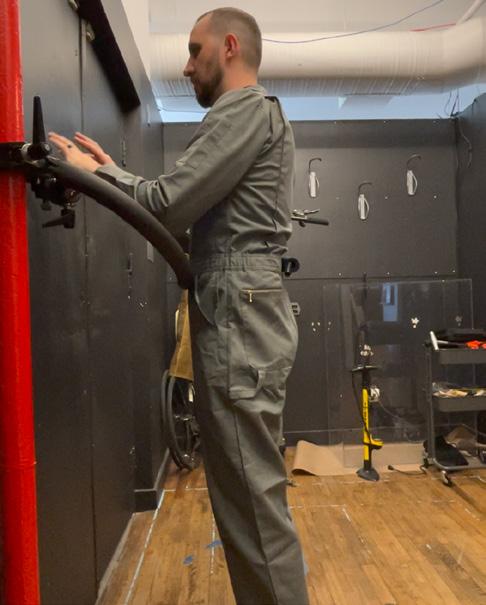

73
the
Beyond
Right Stuff
Figure 5.5 (Top) A variety of puff sewing patterns for the comfort pads; Figure 5.6 (Bottom Left and Right) Testing an early gooseneck prototype in a 1G environment


combinations and attachments that would enable the arms to interface with existing environments, tools, equipment, and other crew, as well as ergonomic pads for added comfort.
I began by focusing on designing the arms of the system, as they were the critical component that would hold and support all the other attachments. e arms were created using cast foam and exible aluminum, and three di erent lengths were designed to t a variety of uses. As a bonus, the arms are extremely lightweight at roughly 120g per meter. is is especially important in terms of launch cost in comparison to the existing R&MAs.
Comfort during use was a primary consideration, and to achieve this, the arms can be tted with Polyimide Foam comfort pads upholstered with Nomex. Polyimide foam is known for its high-temperature resistance and mechanical strength. It is inherently re-resistant and emits virtually no smoke or toxic by-products when exposed to open ame. Nomex has excellent thermal, chemical, and radiation resistance and is used in various industries to create clothing and equipment that can withstand intense heat. ese pads were so , exible, and easy to remove for cleaning or replacement.
e arms of the system were created to be versatile and functional, allowing users to easily access and manipulate objects while in space. ey can hold various objects, via clips, hubs, and magnetic pads. ese attachments can be easily attached or detached from the arms, depending on the user’s needs, making it incredibly easy for individuals to customize their environment and workspaces.
e clips and hubs can be used to hold tools, while the magnetic pads provide a secure surface for attaching any equipment or device with a receiving patch. is versatility makes the MESA system an ideal candidate for a range of applications in space, from scienti c research to routine maintenance tasks.
To interface with the specialized seat tracks already in use on the International Space Station (ISS), the project team created a spring-loaded receiver that could attach to the seat tracks and lock into place with a simple twist mechanism. e exible arms of the MESA system could then be inserted into the receiver via a friction t.
e MESA project’s innovative and adaptable design makes it an ideal candidate for space missions in the near future. One of the key advantages of the MESA system is its lightweight construction, which is essential for space travel due to the high cost of launch and limited payload capacity. e arms are made of cast foam and exible
76
aluminum, which reduces their overall weight while maintaining durability and strength.

Furthermore, the MESA system’s materials have achieved the highest Technology Readiness Level (TRL) of 9, indicating that they have been thoroughly tested and validated for their intended use in space. is achievement is a signi cant milestone for the project, as it means that the MESA system’s materials are space-ready and have met all the necessary requirements for safe use in space.
e MESA system’s spring-loaded receiver, which can attach to the specialized seat tracks on the International Space Station (ISS), is another key feature that makes it an ideal candidate for upcoming missions. e system can be quickly and easily installed and removed from the ISS seat tracks, providing astronauts with an ergonomic and customizable workspace.
e team’s commitment to creating a more inclusive and accessible future for space travel was evident in their work. ey recognized that the design of space accessories had to take into account the lived experiences of individuals with disabilities, resulting in solutions that were both functional and accessible.
I recognized that designing for individuals with disabilities required creating environments that enabled everyone to reach their full potential, not just making things more accessible. e MESA project was a testament to the power of collaboration and creativity, resulting in innovative solutions that could transform the way we think about design in space.
77 Beyond the Right Stuff
Figure 5.7 A section view of an early prototype showing the aluminum core surrounded by expanded foam
e MESA project has been making great strides towards providing people with disabilities more independence in space. One of the most exciting developments is the upcoming zero-G ight test with AstroAccess, a program that provides people with disabilities the opportunity to experience a zero-gravity environment. e MESA prototypes will be tested on this ight to assess their usability and functionality in a microgravity environment.
During the ight, the MESA arms will be put through their paces, holding and supporting individuals and various objects, including clips, hubs, and magnetic pads. e goal is to see how the arms perform in zero-gravity conditions and whether the ergonomic accessories can be easily customized to meet the unique needs of individuals in space.

78
Figure 5.8 Devices can interface with the MESA suite via magnetic attachments
e zero-G ight test is a signi cant step towards proving the readiness of the MESA system for space. I am con dent in the lightweight design and the use of materials that have already been validated with the highest technology readiness level of 9. However, the zero-G ight test will provide critical data to ensure that the system meets the rigorous standards required for use in space.
I am thrilled to be partnering with AstroAccess for this important test. e insights and feedback gained from this ight will help me re ne the design and make any necessary adjustments before moving forward with further testing and eventual implementation on future space missions. is is an exciting and crucial milestone in the development of the MESA system, and I look forward to seeing the results.
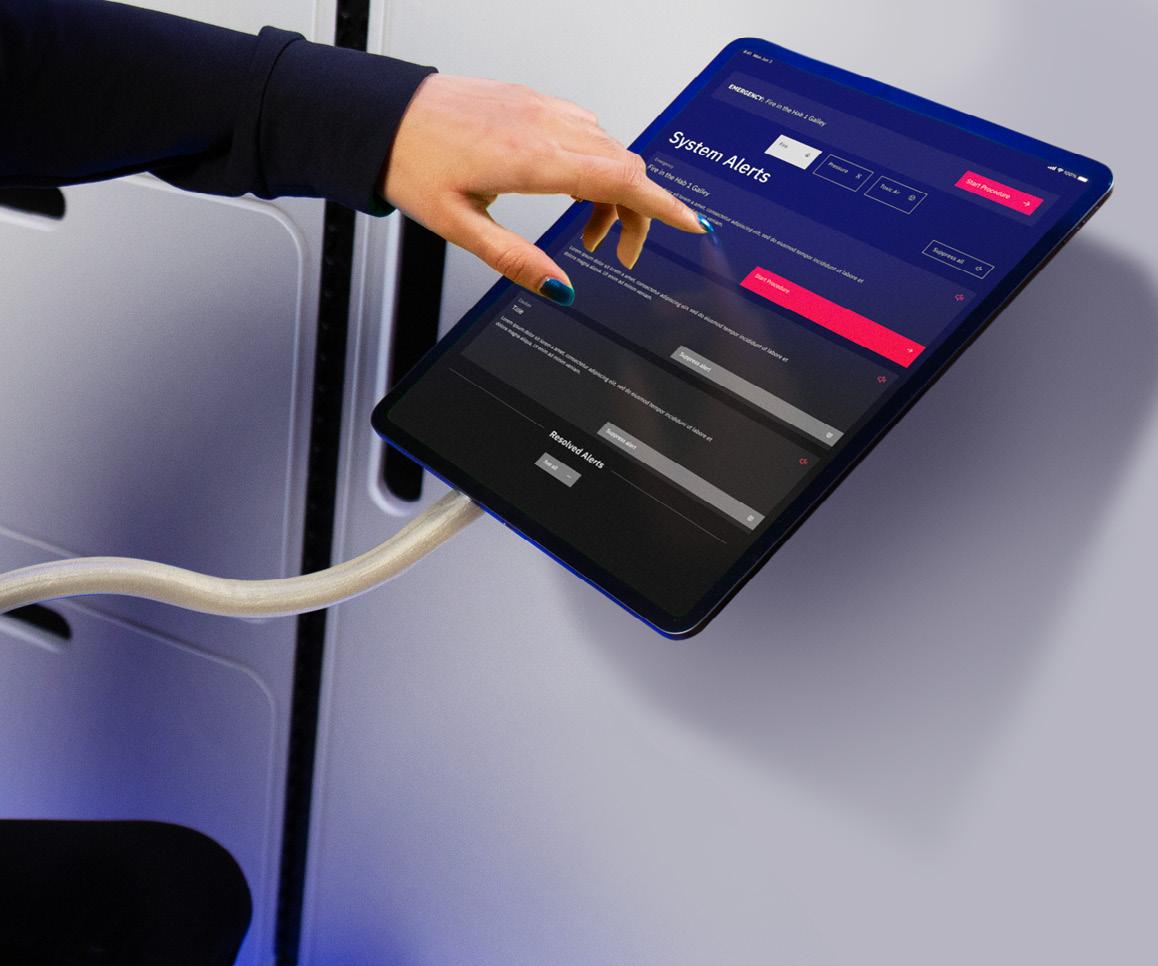
79 Beyond the Right Stuff
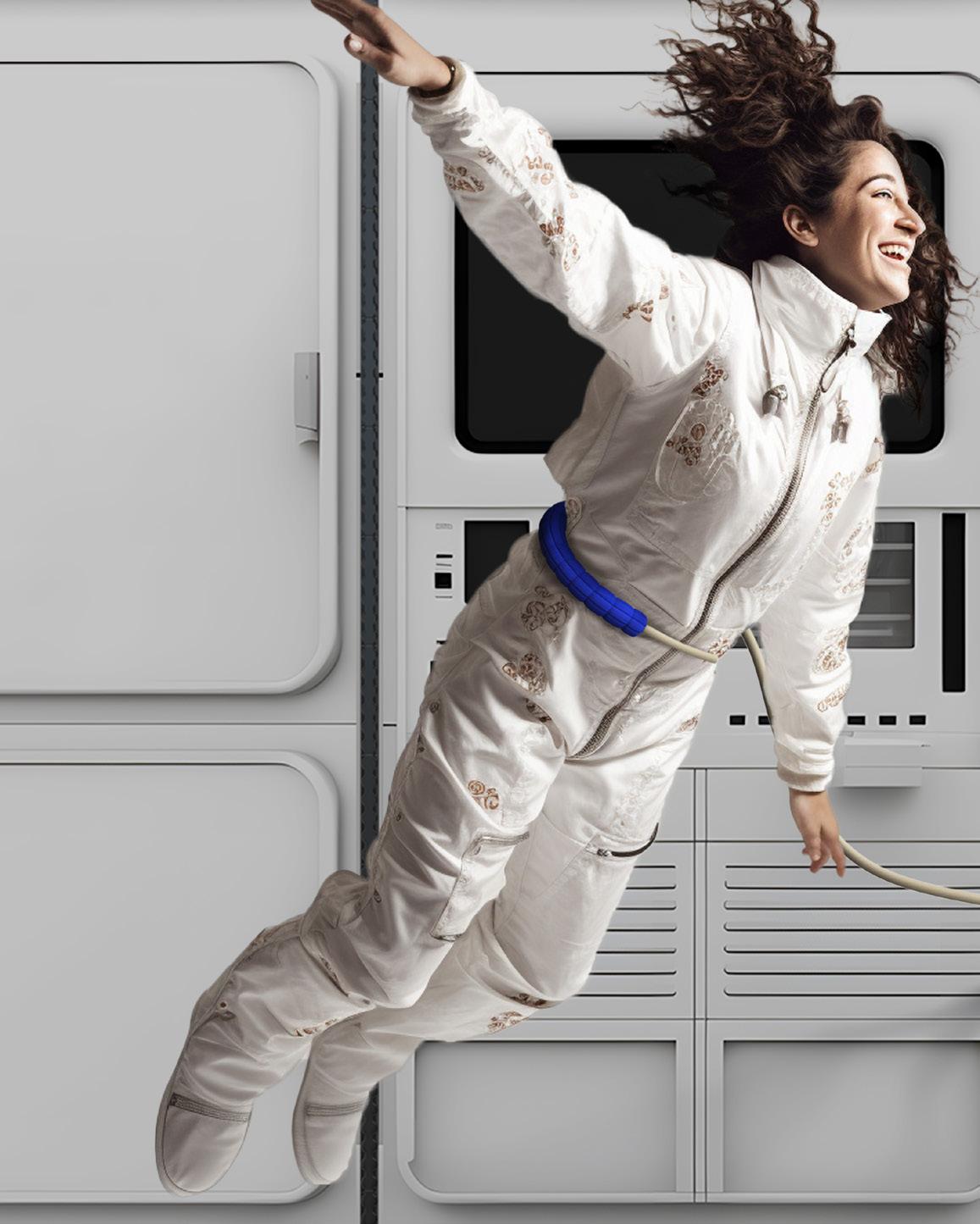

82
Future Opportunities
e design of spacesuits for people with disabilities is a crucial step in promoting disability inclusion in human space ight. e use of assistive technologies, such as exoskeletons or robotic arms, could enable people with mobility impairments to participate in EVA activities. Universal design principles, which prioritize accessibility for all users, can ensure that the suits are adaptable and comfortable for people with di erent types of disabilities. User-centered design methods can also involve the participation of people with disabilities in the design process to address their speci c needs and preferences.
Designing habitats and vehicles for lunar and Martian settlements is another opportunity for promoting disability inclusion. Since the gravity on the Moon and Mars is lower than on Earth, understanding how this a ects the health and functioning of people with disabilities is crucial. By creating inclusive design standards and regulations, these settlements can be designed to ensure that people with disabilities have equal access to housing, transportation, and other essential services.
Expanding the scope of research to include more diverse disability communities is also necessary for promoting disability inclusion. By engaging these communities in co-design processes, designers can gain valuable insights into the speci c needs and preferences of people with di erent types of disabilities. Addressing stereotypes and stigma about disability is also important in creating inclusive design solutions.
Inclusive workplace design for microgravity environments can promote equal opportunities for people with disabilities who want to work in space-related elds. Providing reasonable accommodations and assistive technologies can help individuals with disabilities perform their jobs e ectively. Mentoring programs can also provide support and guidance to individuals with disabilities in these elds.
83 Beyond the Right Stuff
Designing public spaces and services that are accessible and inclusive is crucial for promoting disability inclusion in microgravity environments. By applying universal design principles and removing physical, communication, and attitudinal barriers, individuals with disabilities can have equal access to public spaces and services.
Designing policies and regulations that protect the rights and interests of people with disabilities in microgravity environments is another important step in promoting disability inclusion. Complying with international humanitarian law and human rights law, ensuring participation and representation of people with disabilities in decision-making processes, and addressing disability-related concerns such as stigma or discrimination are essential for creating an inclusive environment.
Designing launch vehicles that are accessible and inclusive for people with disabilities who want to travel to microgravity environments is also necessary. is involves considering the e ects of high acceleration, vibration, noise, and pressure on people with di erent types of disabilities, and providing appropriate accommodations, safety features, and comfort measures.
Designing missions that last for months or years in microgravity environments is also a critical opportunity for promoting disability inclusion. Studying how microgravity a ects the health and well-being of people with disabilities over time is crucial, as is providing opportunities for social interaction, recreation, education, and personal growth for people with disabilities on long-duration missions.
Designing spacecra that can sustain human life for generations in interstellar travel is another opportunity for promoting disability inclusion. is involves creating a self-su cient ecosystem that can provide food, water, air, and energy for people with disabilities on board. Addressing ethical, social, and cultural issues related to disability inclusion in generational spacecra , such as diversity, reproduction, governance, and identity, is also essential. By taking these steps, we can ensure that people with disabilities have equal access to opportunities and services in human space ight activities.
Public accommodations are another important aspect of disability inclusion in human space ight activities. Designing public spaces and services that are accessible and inclusive for people with disabilities who visit or live in microgravity environments is essential for promoting equal opportunities and fostering a sense of community. is could involve applying universal design principles, which prioritize
84

85 Beyond the Right Stuff
Figure 6.1 A U.S. spacesuit attached to the wall inside the Quest Airlock as the Expedition 50 crew prepares for upcoming spacewalks to install new batteries on the station PHOTO BY NASA

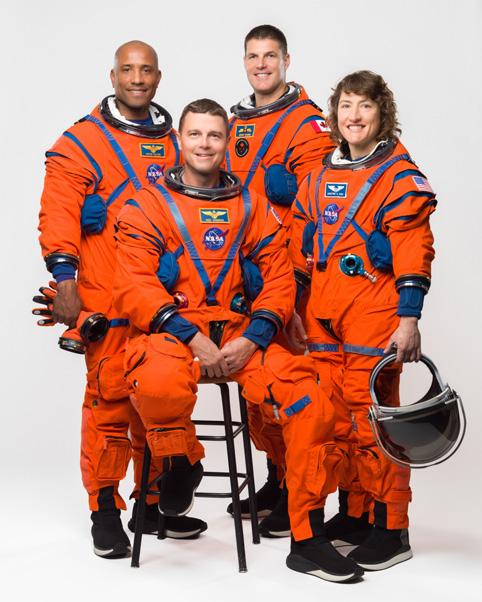
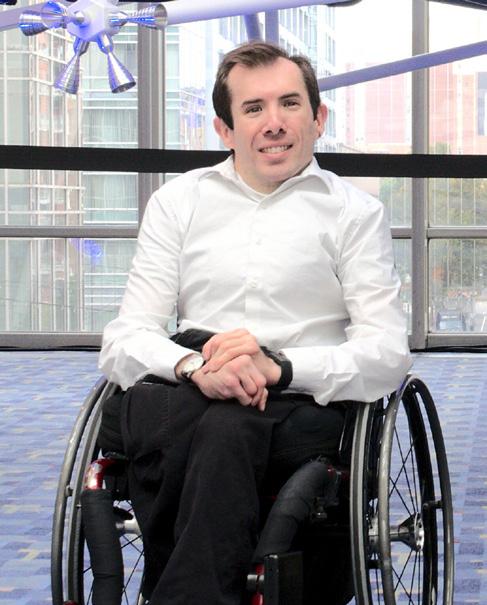
86
Figure 6.2 (Top) Illustration of Artemis astronauts on the Moon IMAGE FROM NASA; Figure 6.3 (Bottom Left) Artemis II astronauts, who will venture around the Moon on the frst crewed mission on NASA’s path to establishing a long-term presence there
PHOTO BY NASA; Figure 6.4 (Bottom Right) Eric Ingram, an AstroAccess Ambassador and NASA Astronaut applicant PHOTO BY SCOUT SPACE
the needs of people with disabilities from the outset of design, and removing physical, communication, and attitudinal barriers. Engaging people with disabilities in codesign processes is also crucial to ensuring that their speci c needs and preferences are addressed.
State and local government services in microgravity environments must also be designed to protect the rights and interests of people with disabilities. is could involve developing policies and regulations that comply with international humanitarian law and human rights law, ensuring participation and representation of people with disabilities in decision-making processes, and addressing disabilityrelated concerns such as stigma or discrimination. Health care, education, social security, and justice must all be accessible and inclusive for people with disabilities in these environments.
Launch vehicle design is also important in promoting disability inclusion in human space ight activities. Designing launch vehicles that are accessible and inclusive for people with disabilities who want to travel to microgravity environments, such as rockets or spaceplanes, involves considering the e ects of high acceleration, vibration, noise, and pressure on people with di erent types of disabilities, and providing appropriate accommodations, safety features, and comfort measures. Reducing the cost per pound of payload is also necessary to make space travel more a ordable and accessible for people with disabilities.
Long duration missions are another aspect of disability inclusion in human space ight activities that require careful consideration. Designing missions that last for months or years in microgravity environments, such as on the International Space Station or a future lunar base, involves studying how microgravity a ects the health and well-being of people with disabilities over time, and how to prevent or mitigate potential risks such as muscle atrophy, bone loss, or psychological stress. Providing opportunities for social interaction, recreation, education, and personal growth for people with disabilities on long duration missions is also important to ensure their well-being and sense of belonging.
Finally, designing generational spacecra that can sustain human life for generations in interstellar travel requires careful consideration of disability inclusion. Creating a self-su cient ecosystem that can provide food, water, air, and energy for people with disabilities on board is essential. Addressing ethical, social, and cultural issues related to disability inclusion in generational spacecra , such as diversity, reproduction, governance, and identity, is also necessary to ensure that people with disabilities are fully integrated into the mission and the community.
87 Beyond the Right Stuff

88
Figure 6.5 A rendering of Blue Origin’s space station design, Orbital Reef IMAGE FROM BLUE ORIGIN
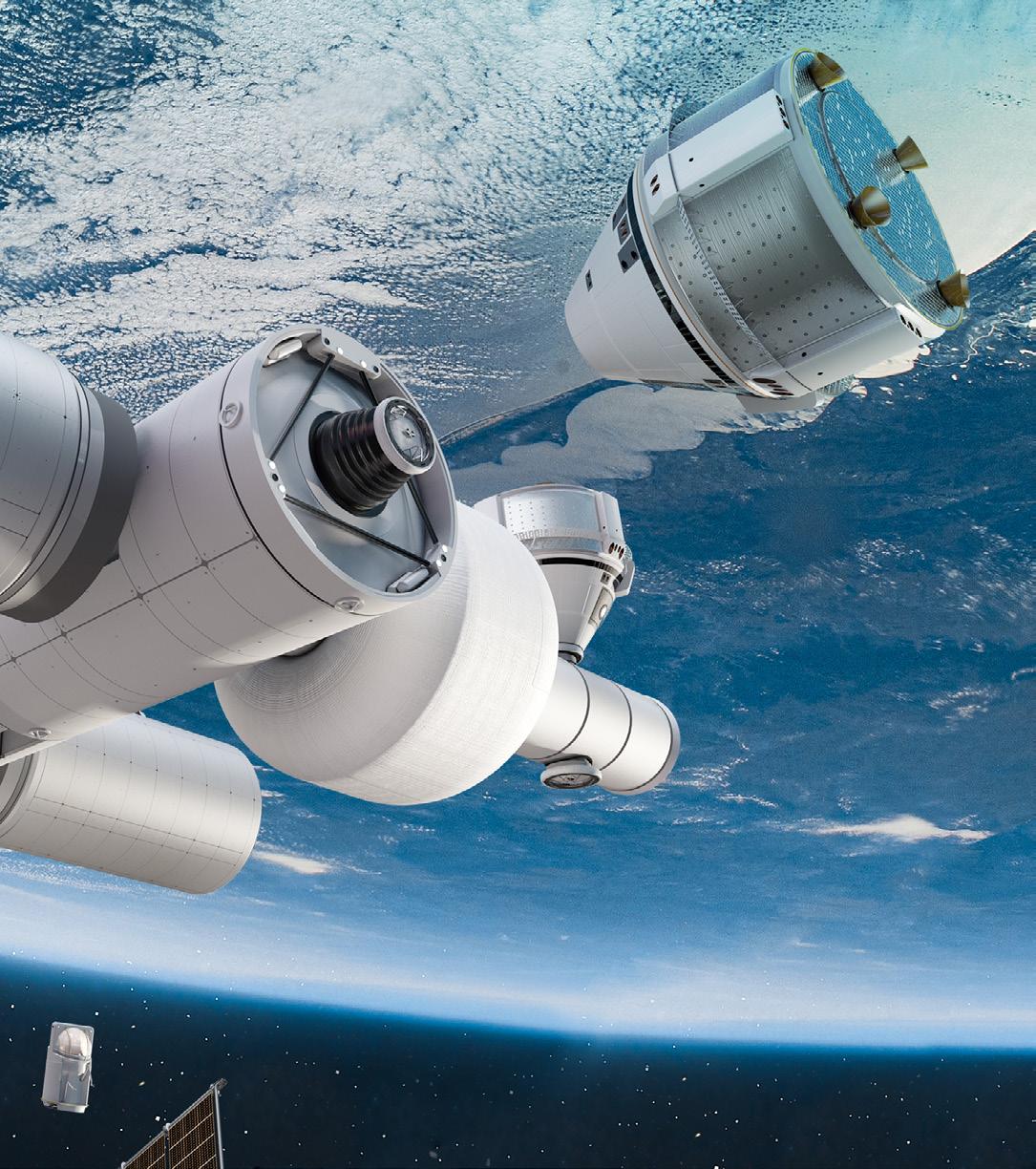
89 Beyond the Right Stuff
Furthermore, the design of workplaces and training programs that are accessible and inclusive for people with disabilities is also critical for employment opportunities in microgravity environments. Equal opportunities, reasonable accommodations, assistive technologies, and mentoring programs are some of the key factors to consider for ensuring a workplace that is inclusive for all. Additionally, public spaces and services, such as restaurants, hotels, theaters, museums, libraries, parks, or schools, should be designed to be accessible and inclusive for people with disabilities. is can be achieved by applying universal design principles, removing physical, communication, and attitudinal barriers, and engaging people with disabilities in co-design processes.
State and local government services also play an essential role in disability inclusion. It is crucial to design policies and regulations that protect the rights and interests of people with disabilities in microgravity environments, such as health care, education, social security, or justice. is can be achieved by complying with international humanitarian law and human rights law, ensuring participation and representation of people with disabilities in decision-making processes, and addressing disabilityrelated concerns such as stigma or discrimination.
Designing launch vehicles that are accessible and inclusive for people with disabilities who want to travel to microgravity environments, such as rockets or spaceplanes, is another critical aspect of disability inclusion. Designers must consider the e ects of high acceleration, vibration, noise, and pressure on people with di erent types of disabilities and provide appropriate accommodations, safety features, and comfort measures. It is also essential to reduce the cost per pound of payload to make space travel more a ordable and accessible.
Finally, designing spacecra that can sustain human life for generations in interstellar travel, such as to another star system, is another critical area of focus for disability inclusion. Creating a self-su cient ecosystem that can provide food, water, air, and energy for people with disabilities on board is necessary for long-duration missions. Additionally, ethical, social, and cultural issues related to disability inclusion in generational spacecra s, such as diversity, reproduction, governance, and identity, must be addressed.
90

91 Beyond the Right Stuff
Figure 6.5 Axiom Space’s EVA (Extra Vehicular Activity) suit
PHOTO BY AXIOM SPACE
92
Acknowledgements
I would like to take this opportunity to express my sincere gratitude to the following individuals who have contributed to the success of my master’s thesis in ways that words cannot fully describe:
First and foremost, I would like to thank my partner, Lauren McClelland, for her unwavering support throughout this entire journey. ank you for moving to New York, for loving me, and for reminding me why I chose to do this. I am grateful for your presence, especially during the challenging times when I was being attacked by intrusive thoughts and negativity.
I am also immensely grateful to Dr. Sheri Wells-Jensen for her invaluable support and guidance. Sheri, you came into my life at the perfect time, and I believe that your partnership in this work is changing the course of humanities future in space and on Earth. ank you for letting me in and supporting me when the challenges seemed insurmountable.
I would also like to thank George Whitesides and Anna Voelker for inviting me into the AstroAccess family. is partnership was essential to the success of my work, and I could not have done it without your support.
I would like to acknowledge the contributions of Michi, Sana, Jose Luis, and Viktoria, whose time and attention were invaluable to this work. Your dedication to this project, including calls, meetings, emails, and voice notes, were critical to its success.
I extend my gratitude to Sara Hendren, whose support was crucial during those moments when the work seemed unclear. Each of our calls le me inspired and with a sense of clarity.
ank you, Cady Coleman, for taking the time to work with Michi and me in
93 Beyond the Right Stuff

94
Figure 7.1 Sarah, Corey, and Sheri saying goodbye after a week together in Houston
Houston to ensure that we could learn as much as possible on our ight. Your expertise and guidance were invaluable.
I would also like to thank the 2023 Cohort for their support and encouragement throughout this program. e many months we spent together in the trenches le an imprint on me and changed me for the better. I would not have been able to complete this program without your amazing talents and support.
I would like to express my gratitude to Chancey Fleet and the New York Public Library for opening their doors to AstroAccess and allowing us to use their time and resources to explore our future in space.
ank you, Dr. Brian, for your extensive material science knowledge and support as I ventured into the unknown.

Finally, I extend my heartfelt thanks to Joe, who put the cherry on top of this work. Your contribution was invaluable, and I am grateful for your support.
ank you to everyone who supported me throughout this journey. I am grateful for your contributions, and I could not have accomplished this without your help.
95 Beyond the Right Stuff
Figure 7.2 Retired Astronaut Cady Coleman testing out the Wearable Anchoring experiment
Bibliography
Clarkson, J. (2003) Inclusive Design: Design for the whole population. London: Springer.
Dusenberry DO, Simpson H, Dellorusso SJ. E ect of handrail shape on graspability. Appl Ergon. 2009 Jul;40(4):657-69. doi: 10.1016/j.apergo.2008.05.006. Epub 2008 Oct 26. PMID: 18952204.
Erlandson, R.F. (2008) Universal and accessible design for products, services, and Processes. Boca Raton: CRC Press.
Haeuplik-Meusburger, S. (2010) ‘My home is my spaceship - an investigation of extra-terrestrial architecture from a human perspective’, 40th International Conference on Environmental Systems [Preprint]. doi:10.2514/6.2010-6021.
Hamraie, A. (2017) Building access: Universal design and the politics of disability. Minneapolis: University of Minnesota Press.
Häuplik-Meusburger, S. (2011) Architecture for astronauts: An activity-based approach. Wien: Springer.
Heiss, O., Degenhart, C. and Ebe, J. (2010) Barrier-free design: Principles, planning, examples. Munich: Institut für Internationale Architektur-Documentation.
Hendren, S. (2020) What can a body do? how we meet the built world. New York, N.Y: Riverhead Books.
Holmes, K. (2020) Mismatch: How inclusion shapes design. Cambridge, MA: e MIT Press.
Häuplik-Meusburger, S. and Gri n, B. (no date) e interesting challenges of designing for humans in space, SPOOL. Available at: https://spool.ac/index.php/spool/article/view/197.
Jorgensen, C.A. (1999) International Space Station Evolution Data Book. Hampton, VA: National Aeronautics and Space Administration, Langley Research Center.
Leach, N. (2014) Space architecture: e New Frontier for Design Research. London: John Wiley & Sons.
Matamu, H. (no date) Speculation on architecture in the absence of gravity: How might architectural elements and design strategies function in outer space? master explanatory document. thesis.
96
Rando, C.M. et al. (2007) ‘Use of cautions and warnings within International Space Station Procedures: When too much information becomes risky’, Proceedings of the Human Factors and Ergonomics Society Annual Meeting, 51(20), pp. 1435–1438. doi:10.1177/154193120705102013.
Schlacht, Irene. (2012). SPACE HABITABILITY. Integrating Human Factors into the Design Process to Enhance Habitability in Long Duration Missions. 10.14279/depositonce-3093.
Sheri Byrne-Haber, C. (2019) Accessibility okrs, Medium. Available at: https://sheribyrnehaber.medium. com/accessibility-okrs-c304d600926e (Accessed: 14 May 2023).
Vessel, E.A. and Russo, S., 2015. E ects of reduced sensory stimulation and assessment of countermeasures for sensory stimulation augmentation. NASA Rep.
Ward, E. (2022) He’s a Paralympian, a surgeon and now the rst disabled astronaut, e New York Times. Available at: https://www.nytimes.com/2022/11/24/world/europe/uk-disabled-astronaut-esa.html (Accessed: 14 May 2023).
Wells-Jensen, S. (2018) e case for disabled astronauts, Scienti c American Blog Network. Available at: https://blogs.scienti camerican.com/observations/the-case-for-disabled-astronauts/ (Accessed: 14 May 2023).
97 Beyond the Right Stuff
Beyond the Right Stu
Designing for Disability Inclusion in Space
“Beyond the Right Stu : Designing for Disability Inclusion in Space” is an overview of Corey McClelland’s Masters thesis work which challenges the traditional notion of “ e Right Stu ” in the selection process for space exploration. Starting with NASA’s selection of the Mercury 7, the de nition of “ e Right Stu ” has slowly widened but still excludes highly quali ed individuals with disabilities. Corey’s work, in partnership with the non-pro t organization AstroAccess, explores how people with disabilities can live and work in space through the emerging eld of disability-led design.
Corey’s prototypes not only demonstrate the feasibility of disability inclusion in space, but also show that it can be good for business, make space safer, and drive innovation. is book is a call to action to widen the de nition of “ e Right Stu ” even further as we enter the new space age. rough disability-led design, Corey o ers a new way of thinking about accessibility that goes beyond universal design and inclusive design, making this book an essential read for anyone interested in the future of space exploration.
Corey McClelland
Corey McClelland is an accomplished designer with over ten years of experience in various elds of design. Due to having dyslexia, Corey naturally gravitated towards the arts and sciences. He started his career as a graphic designer, but his passion for furniture design led him to independently pursue industrial design. He taught himself all the necessary skills and expanded his expertise to include interaction design and user experience. Corey’s resume includes working for Urban Out tters, Walt Disney Imagineering, and frog designing digital, physical, and mixed experiences.
 Corey McClelland
Corey McClelland













 Figure 2.3 NASA astronaut Cady Coleman plays a fute in the JAXA Kibo laboratory onboard the ISS during free time PHOTO BY NASA
Figure 2.3 NASA astronaut Cady Coleman plays a fute in the JAXA Kibo laboratory onboard the ISS during free time PHOTO BY NASA

 Figure 2.4 Sketches exploring a variety of attachment methods including velcro, clips, and magnets
Figure 2.4 Sketches exploring a variety of attachment methods including velcro, clips, and magnets





 Figure 3.2 JAXA astronaut Aki Hoshide uses a vacuum cleaner during housekeeping operations in the Kibo laboratory of the ISS. PHOTO BY NASA
Figure 3.2 JAXA astronaut Aki Hoshide uses a vacuum cleaner during housekeeping operations in the Kibo laboratory of the ISS. PHOTO BY NASA






 1. Angle
2. Depth
3. Density
4. Diffusion
5. Severity
6. Slope
1. Angle
2. Depth
3. Density
4. Diffusion
5. Severity
6. Slope









































